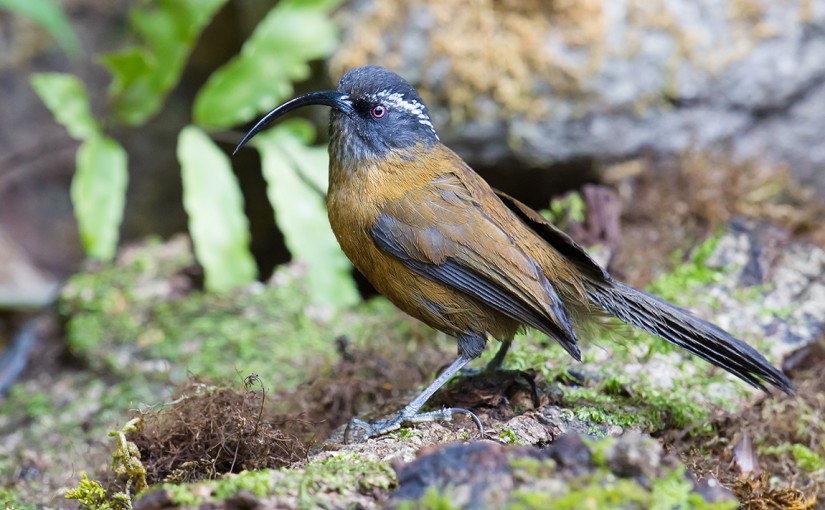by Craig Brelsford and Elaine Du
founders, shanghaibirding.com
ABOUT THE AUTHORS
Craig Brelsford lived in Shanghai from 2007 to 2018. When he departed China in January 2018, Craig was the top-ranked eBirder in that country, having noted 932 species, as well as the top-ranked eBirder in Shanghai (323 species). Elaine Du is from Boli, Heilongjiang. When she left China in February 2018, Elaine was the highest-ranked woman eBirder in China, with 735 species on her list. Craig and Elaine live in Debary, Florida with their son, Tiny, and daughter, Phoebe.
INTRODUCTION
Yunnan is smaller than the U.S. state of California but has more species of bird (919) than the United States and Canada. The province accounts for a little more than 4 percent of the land area of China, but almost two-thirds of China’s species of bird have been recorded there. Western Yunnan, with its wide variety of habitats and proximity to the eastern Himalayas, is particularly bird-rich. In January, February, and March 2014, Craig Brelsford and Elaine Du spent 47 days in western Yunnan, visiting three areas: Tengchong (6 nights), Nabang (14 nights), and Baihualing (25 nights). Craig and Elaine noted 242 species of bird. Our highlights:
• Finding several species of bird with tiny ranges in China, among them Red-wattled Lapwing, Green Bee-eater, Wreathed Hornbill, Stripe-breasted Woodpecker, Black-headed Shrike-babbler, Red-vented Bulbul, Flavescent Bulbul, White-throated Bulbul, Wire-tailed Swallow, Yellow-bellied Warbler, Coral-billed Scimitar Babbler, Cachar Wedge-billed Babbler, Rufous-necked Laughingthrush, Grey-sided Laughingthrush, Blue-winged Laughingthrush, Assam Laughingthrush, Brown-winged Parrotbill, White-breasted Parrotbill, White-tailed Nuthatch, Hume’s Treecreeper, Collared Myna, Burmese Myna, Black-backed Forktail, White-tailed Flycatcher, and Purple Sunbird
• At Baihualing, finding Gould’s Shortwing on four creeks on four days
• At Baihualing, having a thrilling, one-minute close encounter with Slender-billed Scimitar Babbler, the bird of the trip
• At a photo blind at Baihualing, viewing four species of laughingthrush simultaneously for 10 minutes
• At Nabang, viewing four of China’s five species of forktail within the space of 90 minutes; later, at Baihualing, adding Spotted Forktail, the fifth
• Spending four nights at 3180 m (10,430 ft.) on a ridge in the Gaoligong Mountains and birding the upper elevations of that extraordinary range
• Delighting in the combination of healthy forest, rare birds, and ancient history along the 1,500-year-old Tea-Horse Road in the Gaoligong Mountains
BIRDS NOTED IN WESTERN YUNNAN, JANUARY TO MARCH 2014 (242 SPECIES)
Ruddy Shelduck Tadorna ferruginea
Indian Spot-billed Duck Anas poecilorhyncha
Hill Partridge Arborophila torqueola
Rufous-throated Partridge A. rufogularis
Mountain Bamboo Partridge Bambusicola fytchii
Temminck’s Tragopan Tragopan temminckii
Red Junglefowl Gallus gallus
Striated Heron Butorides striata
Chinese Pond Heron Ardeola bacchus
Eastern Cattle Egret Bulbulcus coromandus
Intermediate Egret Egretta intermedia
Little Egret E. garzetta
Great Cormorant Phalacrocorax carbo
Black-winged Kite Elanus caeruleus
Crested Serpent Eagle Spilornis cheela
Black Eagle Ictinaetus malayensis
Eurasian Sparrowhawk Accipiter nisus
Himalayan Buzzard Buteo burmanicus
White-breasted Waterhen Amaurornis phoenicurus
Common Moorhen Gallinula chloropus
Common Crane Grus grus
Ibisbill Ibidorhyncha struthersii
River Lapwing Vanellus duvaucelii
Red-wattled Lapwing V. indicus
Little Ringed Plover Charadrius dubius
Gallinago sp.
Common Sandpiper Actitis hypoleucos
Rock Dove (Feral Pigeon) Columba livia
Speckled Wood Pigeon Columba hodgsonii
Oriental Turtle Dove Streptopelia orientalis
Spotted Dove Spilopelia chinensis
Common Emerald Dove Chalcophaps indica
Mountain Imperial Pigeon Ducula badia
Greater Coucal Centropus sinensis
Large Hawk-Cuckoo Hierococcyx sparverioides
Collared Owlet Glaucidium brodiei
owl sp.
Red-headed Trogon Harpactes erythrocephalus
White-throated Kingfisher Halcyon smyrnensis
Common Kingfisher Alcedo atthis
Crested Kingfisher Megaceryle lugubris
Pied Kingfisher Ceryle rudis
Blue-bearded Bee-eater Nyctyornis athertoni
Green Bee-eater Merops orientalis
Eurasian Hoopoe Upupa epops
Wreathed Hornbill Rhyticeros undulatus
Great Barbet Megalaima virens
Golden-throated Barbet M. franklinii
Blue-throated Barbet M. asiatica
Eurasian Wryneck Jynx torquilla
Speckled Piculet Picumnus innominatus
Grey-capped Pygmy Woodpecker Dendrocopos canicapillus
Stripe-breasted Woodpecker D. atratus
Crimson-breasted Woodpecker D. cathpharius
Darjeeling Woodpecker D. darjellensis
Lesser Yellownape Picus chlorolophus
Bay Woodpecker Blythipicus pyrrhotis
Silver-breasted Broadbill Serilophus lunatus
Bar-winged Flycatcher-shrike Hemipus picatus
Large Cuckooshrike Coracina macei
Black-winged Cuckooshrike C. melaschistos
Grey-chinned Minivet Pericrocotus solaris
Scarlet Minivet P. speciosus
Long-tailed Shrike Lanius schach tricolor
Grey-backed Shrike L. tephronotus
White-bellied Erpornis Erpornis zantholeuca
Black-headed Shrike-babbler Pteruthius rufiventer
Blyth’s Shrike-babbler P. aeralatus
Black-eared Shrike-babbler P. melanotis
Slender-billed Oriole Oriolus tenuirostris
Maroon Oriole O. traillii
Ashy Drongo Dicrurus leucophaeus hopwoodi
Bronzed Drongo D. aeneus
Hair-crested Drongo D. hottentottus
Greater Racket-tailed Drongo D. paradiseus
White-throated Fantail Rhipidura albicollis
Black-naped Monarch Hypothymis azurea
Eurasian Jay Garrulus glandarius
Grey Treepie Dendrocitta formosae
Spotted Nutcracker Nucifraga caryocatactes
Large-billed Crow Corvus macrorhynchos
Yellow-bellied Fantail Chelidorhynx hypoxantha
Grey-headed Canary-flycatcher Culicicapa ceylonensis
Yellow-browed Tit Sylviparus modestus
Coal Tit Periparus ater
Grey Crested Tit Lophophanes dichrous
Japanese Tit Parus minor
Green-backed Tit P. monticolus
Yellow-cheeked Tit Machlolophus spilonotus
Crested Finchbill Spizixos canifrons
Striated Bulbul Pycnonotus striatus
Black-crested Bulbul P. flaviventris
Red-whiskered Bulbul P. jocosus
Brown-breasted Bulbul P. xanthorrhous
Red-vented Bulbul P. cafer
Flavescent Bulbul P. flavescens
White-throated Bulbul Alophoixus flaveolus
Grey-eyed Bulbul Iole propinqua
Mountain Bulbul Ixos mcclellandii
Ashy Bulbul Hemixos flavala
Black Bulbul Hypsipetes leucocephalus
Grey-throated Martin Riparia chinensis
Barn Swallow Hirundo rustica
Wire-tailed Swallow H. smithii
Striated Swallow Cecropis striolata
Pygmy Cupwing Pnoepyga pusilla
Yellow-bellied Warbler Abroscopus superciliaris
Black-faced Warbler A. schisticeps
Brown-flanked Bush Warbler Horornis fortipes
Grey-bellied Tesia Tesia cyaniventer
Chestnut-headed Tesia Cettia castaneocoronata
Black-throated Bushtit Aegithalos concinnus
Black-browed Bushtit A. bonvaloti
Smoky Warbler Phylloscopus fuligiventer weigoldi
Buff-barred Warbler P. pulcher
Ashy-throated Warbler P. maculipennis
Pallas’s Leaf Warbler P. proregulus
Greenish Warbler P. trochiloides
Sichuan Leaf Warbler P. forresti
Member of “golden spectacled warbler” complex
Striated Grassbird Megalurus palustris
Hill Prinia Prinia superciliaris
Rufescent Prinia P. rufescens
Plain Prinia P. inornata
Common Tailorbird Orthotomus sutorius
Black-streaked Scimitar Babbler Pomatorhinus gravivox
Streak-breasted Scimitar Babbler P. ruficollis
Coral-billed Scimitar Babbler P. ferruginosus
Slender-billed Scimitar Babbler P. superciliaris
Cachar Wedge-billed Babbler Sphenocichla roberti
Grey-throated Babbler Stachyris nigriceps
Rufous-capped Babbler Stachyridopsis ruficeps
Rufous-winged Fulvetta Alcippe castaneceps
Rusty-capped Fulvetta A. dubia
Yunnan Fulvetta A. fratercula
Puff-throated Babbler Pellorneum ruficeps
White-crested Laughingthrush Garrulax leucolophus
Lesser Necklaced Laughingthrush G. monileger
Moustached Laughingthrush Ianthocincla cineracea
Spotted Laughingthrush I. ocellata
Rufous-necked Laughingthrush Pterorhinus ruficollis
White-throated Laughingthrush P. albogularis
Black-throated Laughingthrush P. chinensis
Grey-sided Laughingthrush P. caerulatus
White-browed Laughingthrush P. sannio
Blue-winged Laughingthrush Trochalopteron squamatum
Black-faced Laughingthrush T. affine
Assam Laughingthrush T. chrysopterum woodi
Red-tailed Laughingthrush T. milnei
Himalayan Cutia Cutia nipalensis
Blue-winged Minla Minla cyanouroptera
Bar-throated Minla M. strigula
Red-tailed Minla M. ignotincta
Red-faced Liocichla Liocichla phoenicea
Rusty-fronted Barwing Actinodura egertoni
Streak-throated Barwing A. waldeni
Silver-eared Mesia Leiothrix argentauris
Red-billed Leiothrix L. lutea
Grey Sibia Heterophasia gracilis
Black-headed Sibia H. desgodinsi
Beautiful Sibia H. pulchella
Long-tailed Sibia H. picaoides
Golden-breasted Fulvetta Lioparus chrysotis
White-browed Fulvetta Fulvetta vinipectus
Brown-winged Parrotbill Sinosuthora brunnea
Fulvous Parrotbill Suthora fulvifrons
White-breasted Parrotbill Psittiparus ruficeps
Grey-headed Parrotbill P. gularis
Spot-breasted Parrotbill Paradoxornis guttaticollis
Whiskered Yuhina Yuhina flavicollis
Stripe-throated Yuhina Y. gularis
Rufous-vented Yuhina Y. occipitalis
white-eye sp. Zosterops japonicus or Z. palpebrosus
Chestnut-vented Nuthatch Sitta nagaensis
White-tailed Nuthatch S. himalayensis
Velvet-fronted Nuthatch S. frontalis
Hume’s Treecreeper Certhia manipurensis
Collared Myna Acridotheres albocinctus
Common Myna A. tristis
Burmese Myna A. burmannicus
Indian Pied Myna Gracupica contra
Himalayan Thrush Zoothera salimalii
Long-tailed Thrush Z. dixoni
Scaly Thrush Z. dauma
Black-breasted Thrush Turdus dissimilis
Chestnut Thrush T. rubrocanus
Gould’s Shortwing Heteroxenicus stellatus
Himalayan Bluetail Tarsiger rufilatus
Golden Bush Robin T. chrysaeus
Oriental Magpie-Robin Copsychus saularis
White-rumped Shama Copsychus malabaricus
Daurian Redstart Phoenicurus auroreus
Blue-fronted Redstart P. frontalis
Plumbeous Water Redstart P. fuliginosus
White-capped Redstart P. leucocephalus
Chestnut-bellied Rock Thrush Monticola rufiventris
White-tailed Robin Myiomela leucura
Blue Whistling Thrush Myophonus caeruleus eugenei
Little Forktail Enicurus scouleri
Black-backed Forktail E. immaculatus
Slaty-backed Forktail E. schistaceus
White-crowned Forktail E. leschenaulti
Spotted Forktail E. maculatus
Siberian Stonechat Saxicola maurus
Pied Bush Chat S. caprata
Grey Bush Chat S. ferreus
Slaty-backed Flycatcher Ficedula hodgsonii
Rufous-gorgeted Flycatcher F. strophiata
Little Pied Flycatcher F. westermanni
Sapphire Flycatcher F. sapphira
White-tailed Flycatcher Leucoptilon concretum
Hill Blue Flycatcher Cyornis banyumas
Rufous-bellied Niltava Niltava sundara
Large Niltava N. grandis
Small Niltava N. macgrigoriae
Orange-bellied Leafbird Chloropsis hardwickii
Plain Flowerpecker Dicaeum minullum
Fire-breasted Flowerpecker D. ignipectus
Purple Sunbird Cinnyris asiaticus
Mrs. Gould’s Sunbird Aethopyga gouldiae
Green-tailed Sunbird A. nipalensis
Black-throated Sunbird A. saturata
Fire-tailed Sunbird A. ignicauda
Little Spiderhunter Arachnothera longirostra
Streaked Spiderhunter A. magna
Eurasian Tree Sparrow Passer montanus
White-rumped Munia Lonchura striata
Scaly-breasted Munia L. punctulata
Maroon-backed Accentor Prunella immaculata
Citrine Wagtail Motacilla citreola
Grey Wagtail M. cinerea
White Wagtail M. alba
Olive-backed Pipit Anthus hodgsoni
Brambling Fringilla montifringilla
Scarlet Finch Carpodacus sipahi
Vinaceous Rosefinch C. vinaceus
Red Crossbill Loxia curvirostra
Tristram’s Bunting Emberiza tristrami
Little Bunting E. pusilla
Yellow-throated Bunting E. elegans
Black-faced Bunting E. spodocephala
THE TRIP (all dates 2014)
Wed. 15 Jan.
Tengchong
At 11:50, Elaine Du and I took off from Hongqiao Airport in Shanghai for Kunming, the capital of Yunnan. We switched planes in Kunming and continued on to Tengchong, arriving at 17:30. Our contact, Xiāo Xù Qīng (肖旭清), was waiting for us with our van, a Chinese make called Chang An. Xù Qīng drove us to our hotel. Elaine and I ate supper then bought provisions at a grocery store.
Thurs. 16 Jan.
Nabang
All morning and part of the afternoon at Laifengshan (25.016066, 98.487400), the large forest park in Tengchong. At night, we drove across the mountains to Nabang (24.7496583, 97.5540262). We opted to drive at night because after dark the large trucks, many of them laden with timber, would be fewer than in the daytime, and traffic in general would be less. We arrived at our hotel, Biānchuí Jiǔdiàn (边陲酒店; +86 692-8925288). We stayed 14 nights in this hotel. Rooms cost 80 yuan per night. Some rooms at this hotel are subpar; pipes leak in the bathroom, and there is no access to the Internet. Other rooms are more pleasant and have a reliable connection to the Internet. After a few nights in an unpleasant room, we moved to a pleasant room and had a good stay.
Fri. 17 Jan.
Nabang
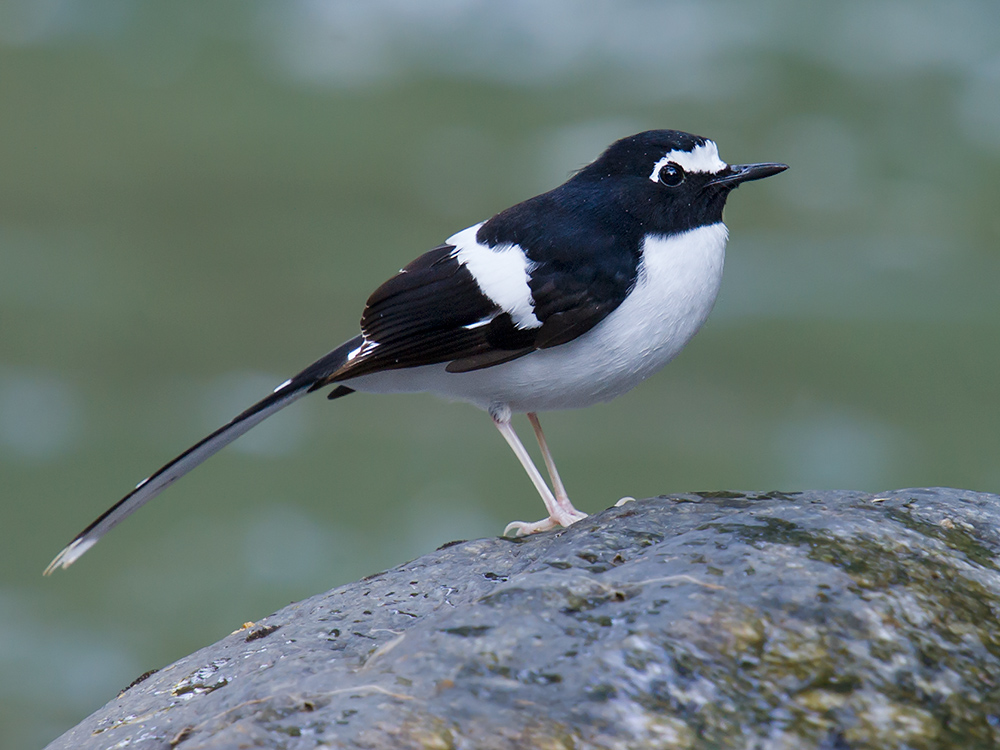
The weather here is so very fine, the air so very clean; what a stark contrast to the dirty air and chilly weather of Shanghai. On our first day and nearly every day thereafter, the daytime temperature in Nabang, elev. 210 m (690 ft.), was reaching about 23 degrees Celsius (73 Fahrenheit); at night, the temperature was dipping to a very comfortable 14 (57).
Thirty kilometers (19 mi.) long, the Nabang-Xima Trail begins at the point north of town where the paved road meets Nabang Creek; a sign reminds drivers that it is illegal to cross the stream into Burma there, and there is no bridge, but cars and motorcycles regularly ford the stream. The Nabang-Xima Trail is the dirt road that stays on the left bank of the creek, on the Chinese side. The first three kilometers (1.9 mi.) of the trail pass through banana plantations and are drivable. We parked at the place where the road becomes impassible for anything but a four-wheel drive vehicle; there, the trail leaves the valley and climbs the ridge. Within minutes of arriving at the parking spot, we found a Black-backed Forktail. Climbing the ridge, I found a flock of White-throated Bulbul, Greater Racket-tailed Drongo, a male Small Niltava, and a female Slaty-backed Flycatcher. In the afternoon, we drove to Rongshu Wang, a nature reserve in the mountains east of Nabang. A big mixed flock was on a massive tree in flower; the main component was Black Bulbul (white-headed as well as all-black morphs); also 1 Blue-throated Barbet and 3 Hair-crested Drongo.
Sat. 18 Jan.
Nabang
Today Elaine and I set up our observation point on the Nabang-Xima Trail. After we set up the tent, we left for the van, not quite a kilometer below at the parking spot. Here in its higher reaches, Nabang Creek is nearly trash-free. We ate lunch on the bank of the creek, hoping to get a better photo of a Black-backed Forktail. We saw Slaty-backed Forktail, Red-headed Trogon, and the region’s distinctive, yellow-billed Blue Whistling Thrush Myophonus caeruleus eugenei. Returning to the tent, we heard White-tailed Flycatcher (00:31; 1.3 MB):
Audio Player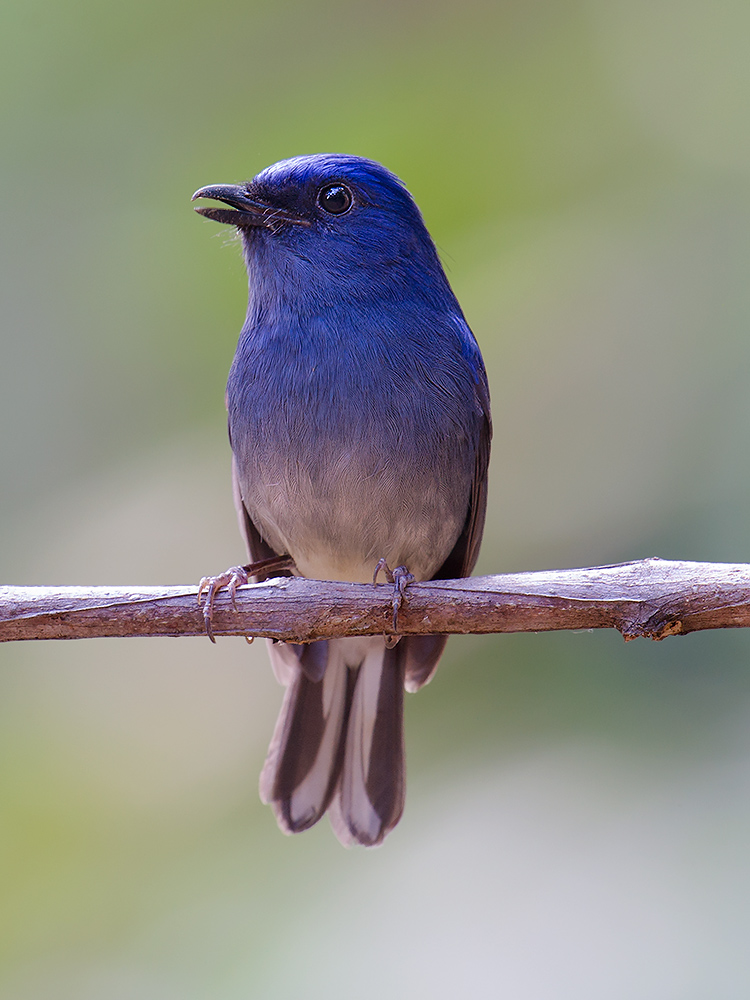
Later, we saw the flycatcher, a male, as well as a male White-tailed Robin. When we emerged from the tent, it was already dark, and fireflies had come out. Elaine had never seen fireflies. Pleasant boyhood memories flooded my mind.
Sun. 19 Jan.
Nabang
Two Wreathed Hornbill at Nabang today! Walking up the Nabang-Xima Trail, at an elevation of about 570 m (1,870 ft.), Elaine and I heard a croaking sound high above. We looked up and saw them. As one ascends, one enjoys brilliant views of the heavily forested hills. Also today: Blue-bearded Bee-eater, 2 Lesser Yellownape, and Maroon Oriole. We sound-recorded and viewed Grey-bellied Tesia and recorded vocalizations of White-tailed Flycatcher at close range.
Mon. 20 Jan.
Nabang
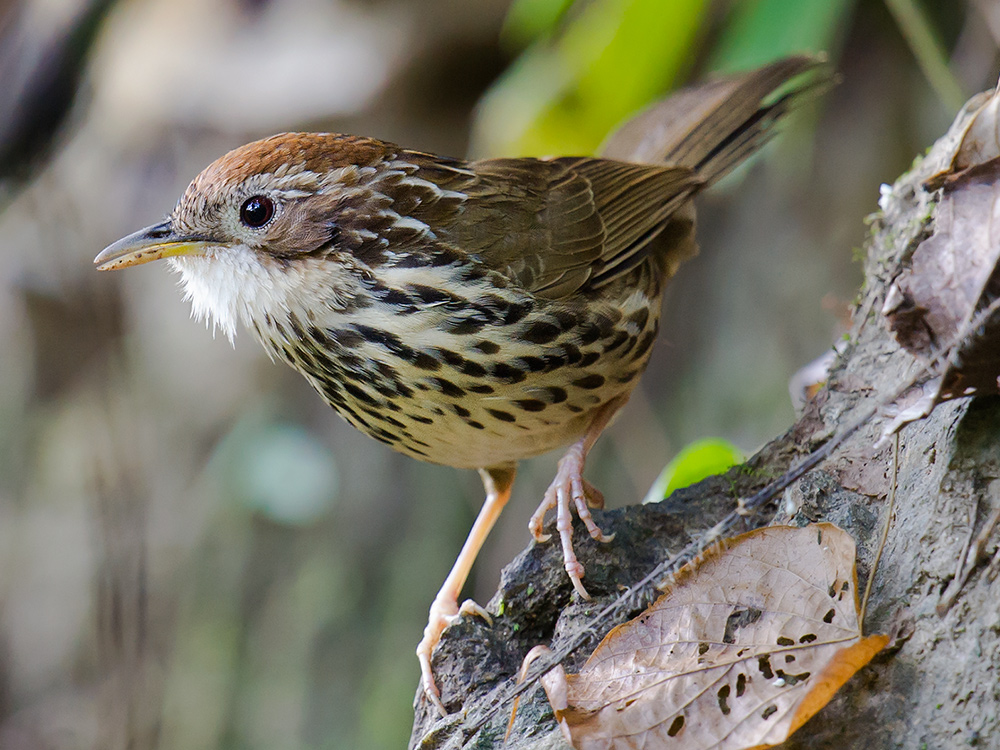
All day along the Nabang-Xima Trail. Highlights: Puff-throated Babbler, 3 Blue-bearded Bee-eater sipping nectar, plus four species that we saw within an hour of each other and never saw again during the trip: White-rumped Shama among 4 Silver-breasted Broadbill, plus 2 White-bellied Erpornis and a single male Little Pied Flycatcher. Saw no one along Nabang-Xima Trail today. Total silence; perfect weather.
Tues. 21 Jan.
Nabang
Today, Elaine and I made our first trip to the Mengnai River. Only 3 km (1.9 mi) long (from the S318 to the confluence of the Mengnai River and Nabang Creek), the Mengnai River Valley contains a number of China rarities. Near the confluence of the Mengnai River and Nabang Creek, I found 5 River Lapwing and 2 Ibisbill.
Wed. 22 Jan.
Nabang
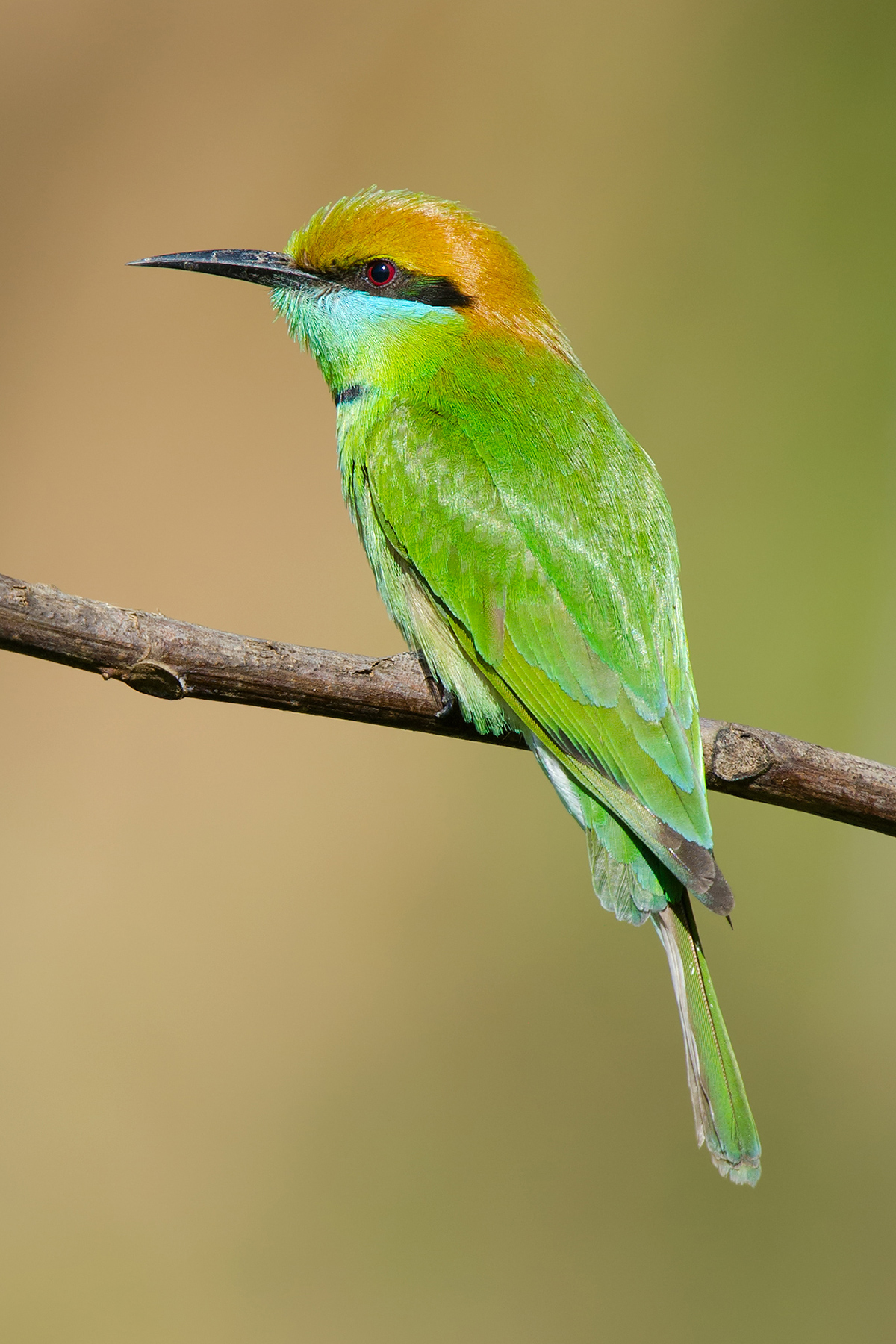
All day in the Mengnai River Valley. We found three Yunnan rarities: 3 Black-backed Forktail plus a flock of Green Bee-eater and a single Red-wattled Lapwing.
Thurs. 23 Jan.
Nabang
Today, once again along the Mengnai River, Elaine and I found a flock of Rufous-necked Laughingthrush. Rufous-necked Laughingthrush is an uncommon resident of the parts of Burma adjacent to Yunnan as well as a small sliver of western Yunnan. The laughingthrushes were in the thicket between the road leading down the valley and the river.
Fri. 24 Jan.
Nabang
At Rongshu Wang, the forest reserve 20 km (12.4 mi) east of Nabang, Elaine and I today found Stripe-breasted Woodpecker, 4 White-breasted Parrotbill, 3 Yellow-bellied Warbler, and 4 Coral-billed Scimitar Babbler. All four species have small ranges in China, mostly or exclusively in western Yunnan.
Sat. 25 Jan.
Nabang
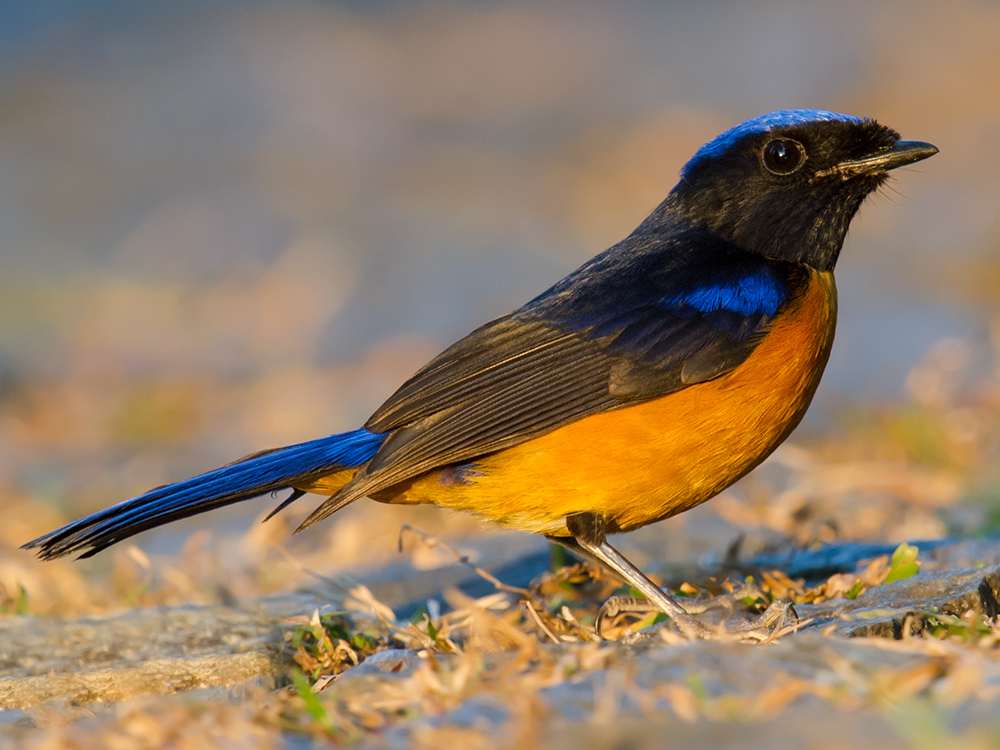
Today ended on a high note. As Elaine and I were driving our Chang An van down the cobblestone road at Rongshu Wang, I saw a Rufous-bellied Niltava fly from the side of the road, where it had just pounced on something, to the safety of the trees. I stopped the van, pulled out my equipment, lay flat on my belly, and waited. Sure enough, the niltava came back. Just as the last rays of the sun were kissing the road, the niltava jumped out. I got off a flurry of shots. What a moment! Earlier at Rongshu Wang, Elaine and I were at a place I’m calling The Patch, not far from the Banyan Hulk. Around this open area, numerous remarkable species appeared, among them White-hooded Babbler (just missed by me, but photographed by a Chinese guide and his client minutes before my arrival). The weather was fine there at elev. 950 m (3,120 ft.), clear and warm with a slight breeze. Another highlight today was our first good views of Mountain Imperial Pigeon.
Sun. 26 Jan.
Nabang
All day at The Patch at Rongshu Wang. A flock of Bar-winged Flycatcher-shrike were of interest, as was the large flock (ca. 30 individuals) of Silver-eared Mesia.
Mon. 27 Jan.
Nabang
Today, for the first time since 17 Jan., Elaine and I did not go out before dawn. We needed the rest! In the afternoon in the Mengnai River Valley, I, like Ahab pursuing Moby Dick, battled for photos of the local Rufous-necked Laughingthrush. They’re easy enough to find in the thicket along the road; but seeing them, let alone photographing them, is a challenge. Elaine and I were often three meters (10 feet) from some of them, allowing us to make good recordings of their babbling (00:24; 1.2 MB):
Audio PlayerTues. 28 Jan.
Nabang
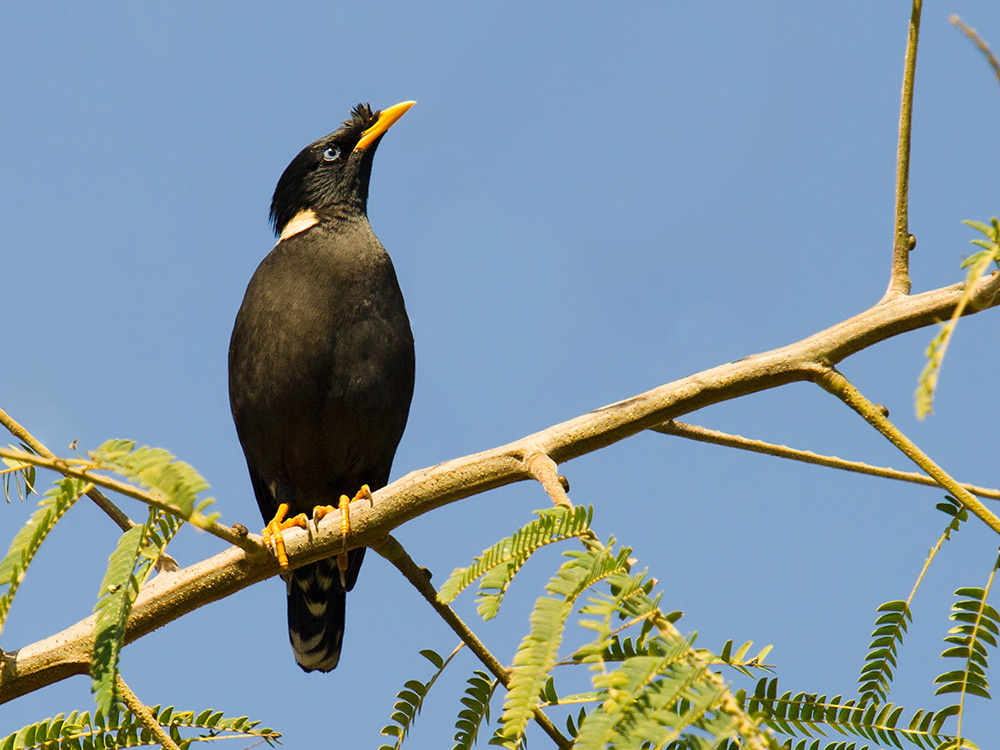
This morning in the Mengnai River Valley, Elaine and I finally found the Big 3 Starlings of Nabang: Indian Pied Myna, Collared Myna, and a pair of Burmese Myna. We also found 3 Wire-tailed Swallow and ca. 15 Grey-throated Martin.
Wed. 29 Jan.
Nabang
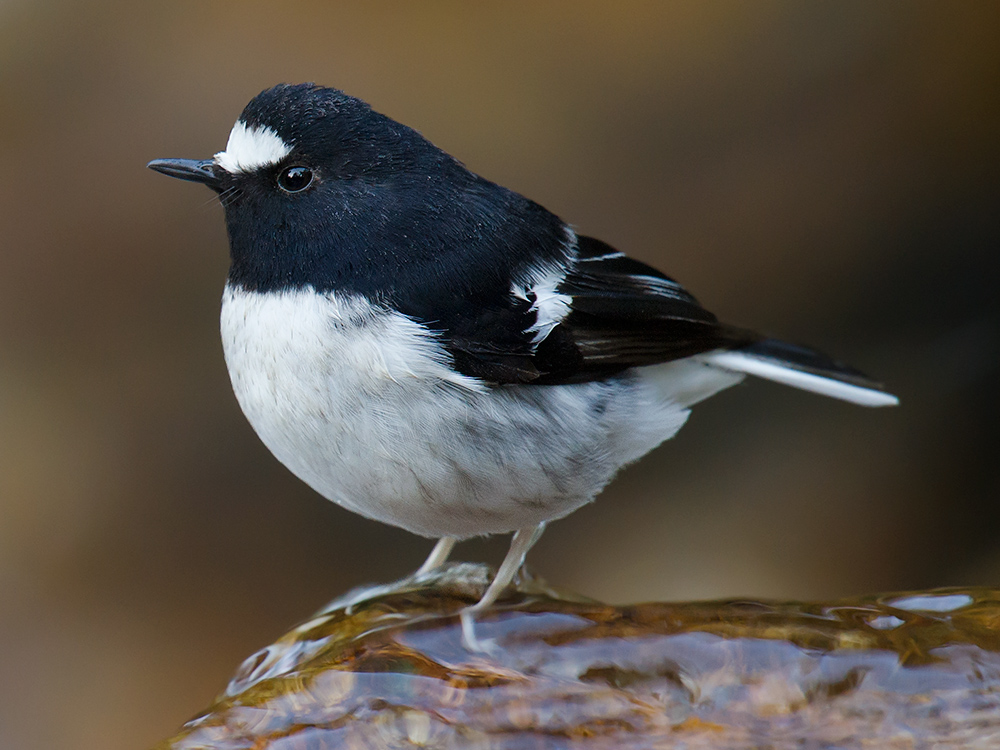
Today in the Mengnai River Valley, Elaine and I once again saw Wire-tailed Swallow and Rufous-necked Laughingthrush. To our trip list we added Eurasian Wryneck then broke for lunch. An afternoon vigil by Nabang Creek produced sustained views of 2 Slaty-backed Forktail. The forktails had no idea that two people were watching them from a tent. Little Forktail appeared but was chased away by Plumbeous Water Redstart. Our much hoped-for Black-backed Forktail did not arrive.
Thurs. 30 Jan.
Nabang
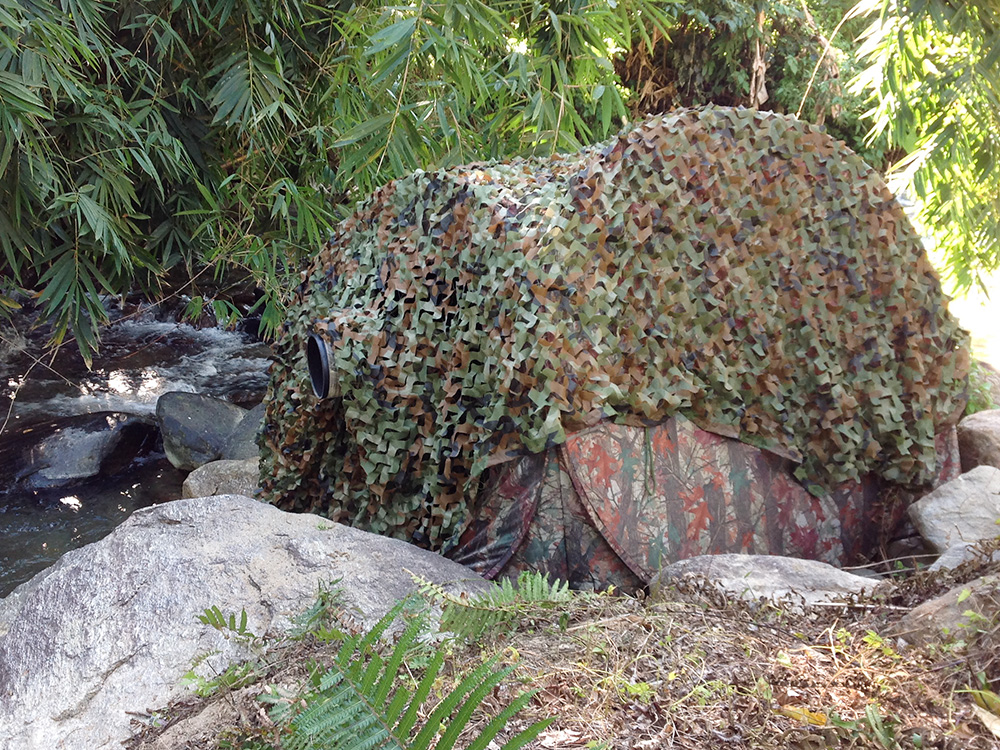
This morning, within the space of just 90 minutes, 4 of China’s 5 species of forktail lingered near our tent. We were set up along Nabang Creek, on the China side of the stream. Yesterday, I agonized over where to site our tent; my careful planning paid off handsomely. The first to arrive was Black-backed Forktail. This individual was not intimidated by the aggressive local Plumbeous Water Redstart. A Little Forktail did, however, have to add the redstart into its calculations. Next came White-crowned Forktail, followed by a pair of Slaty-backed Forktail. In the afternoon, Elaine and I returned to the tent. A Grey Wagtail, completely unaware that we were inside, perched a meter away from our tent. All the forktails except the White-crowned were still in the area. We were flies on the wall, invisible witnesses to the scene unfolding before our eyes.
Fri. 31 Jan.
Tengchong
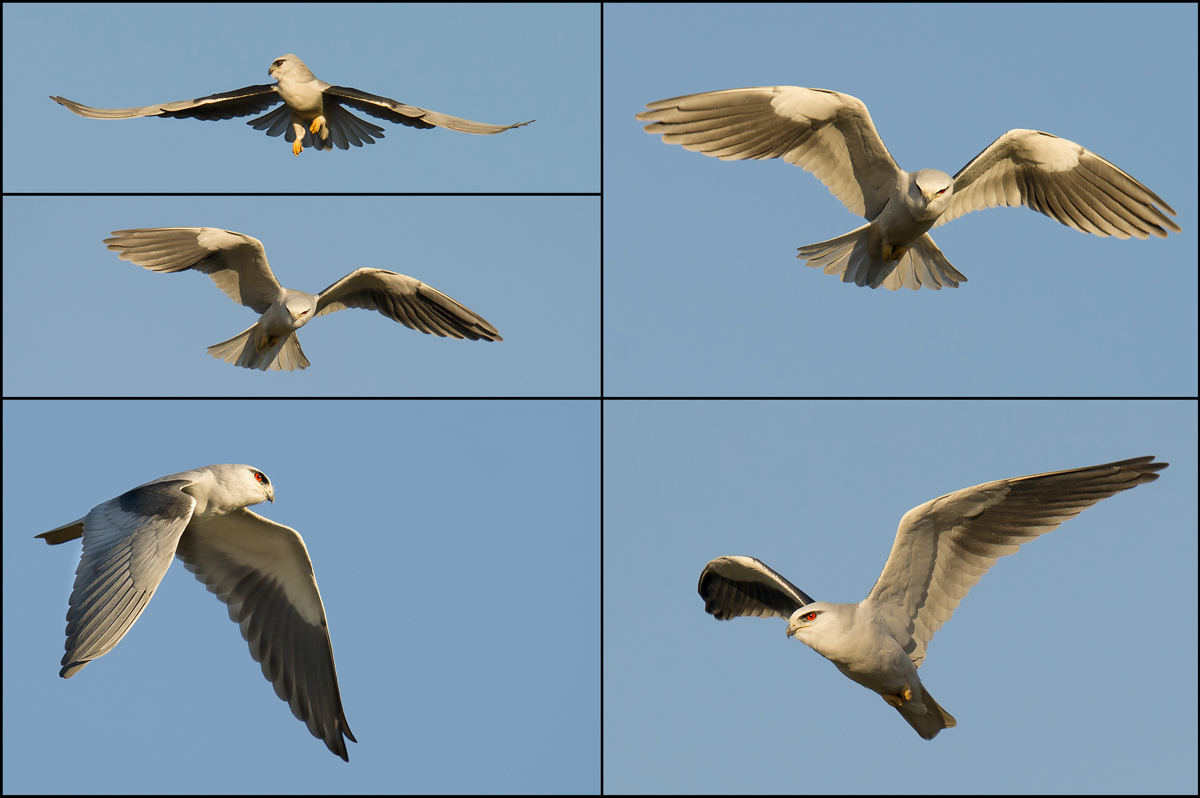
Today, the drive from Nabang to Tengchong netted me my best-ever views of Crested Finchbill. Other highlights were 2 Blue-bearded Bee-eaters and, at Yingjiang (盈江), a Black-winged Kite. Many checkpoints between Yingjiang and Tengchong; yesterday, a jealous husband killed six persons in Tengchong; he’s still on the loose. Today is Chinese New Year. It’s the year of the horse.
Sat. 1 Feb.
Tengchong
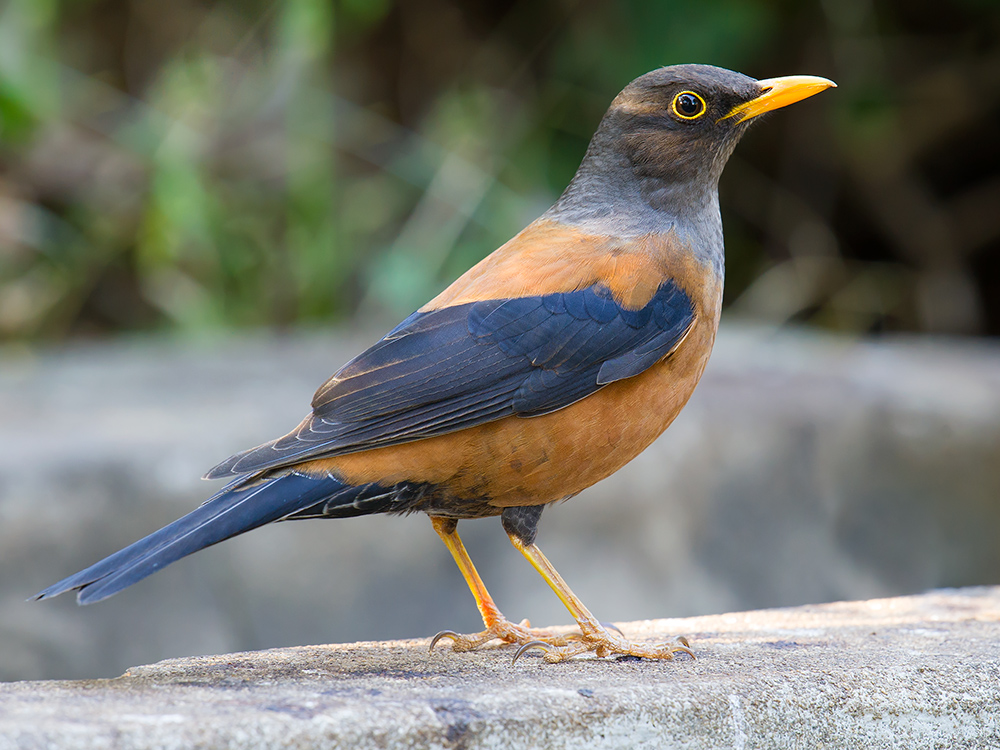
Today at Laifengshan, the mountain park in Tengchong, Elaine and I found a flock of Brown-winged Parrotbill and 3 Red-faced Liocichla. The liocichlas were not terribly bothered by the steady stream of Spring Festival vacationers passing through their territory. Neither were the 2 Red-tailed Minla and single Bar-throated Minla. Other highlights: Scaly Thrush, Chestnut Thrush, 10 Black-breasted Thrush, and Large Niltava. A calling Large Hawk-Cuckoo reminded me of summers farther north. We spent only a few hours at Laifengshan, as the big crowd made birding difficult.
Sun. 2 Feb.
Tengchong
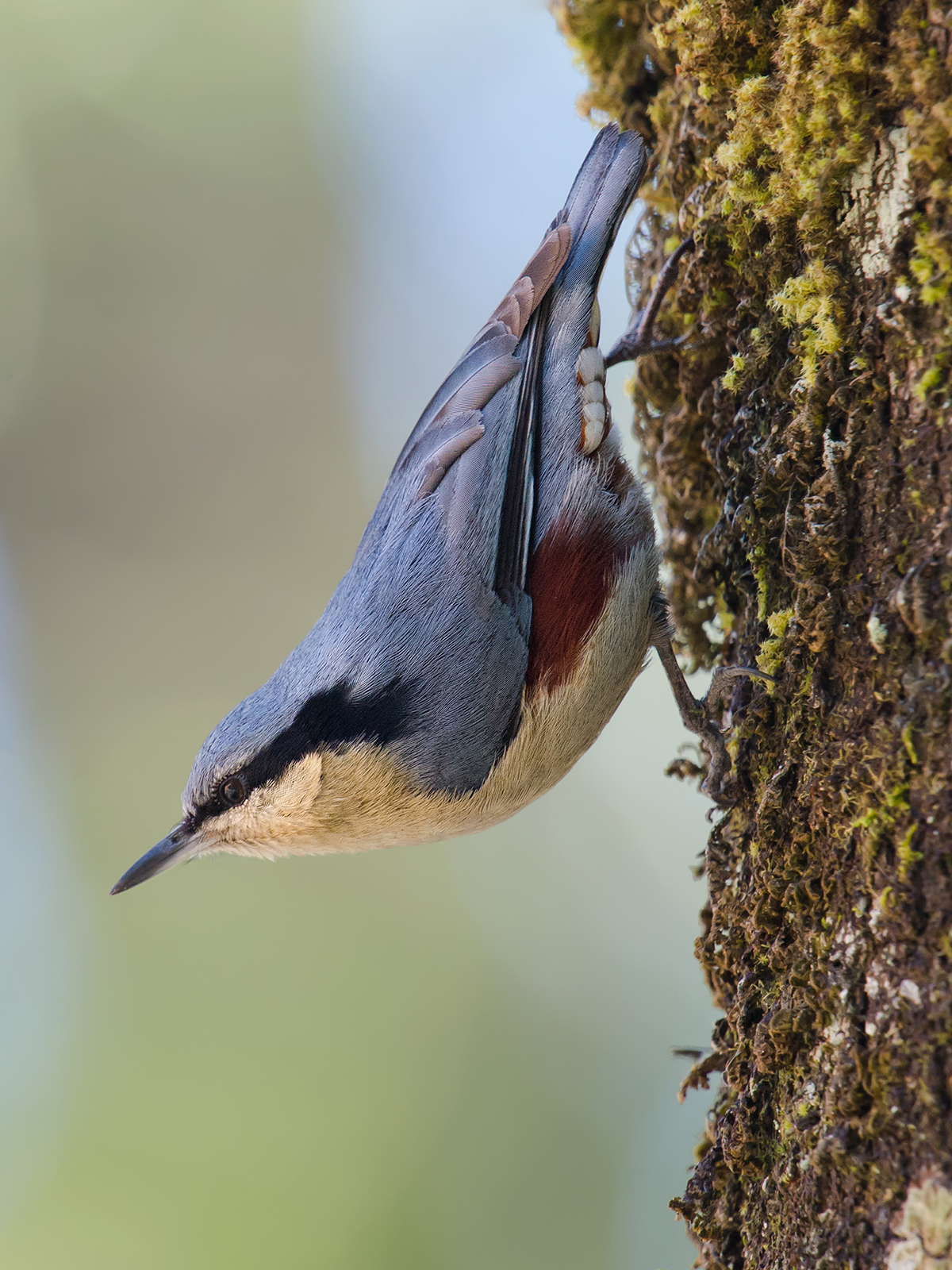
Today, Elaine and I split our time between birding Laifengshan here in Tengchong and preparing for the next big leg of our trip, Gaoligongshan. Dawn saw us atop Laifengshan, where 6 Rufous-vented Yuhina were feeding vigorously. Elaine enjoyed her first views of a male Blue-fronted Redstart. At the temple, we had fun watching Chestnut-vented Nuthatch. These birds sang strongly, evidence that, for some non-migratory species at least, mating season is just around the corner. In the afternoon, Elaine and I set up the tent next to a watering hole. There, I collected clear, full-body images of a male Chestnut Thrush plus male and female Black-breasted Thrush.
Mon. 3 Feb.
Tengchong
At Laifengshan today, Elaine and I spent most of the morning observing and attempting to photograph Slender-billed Oriole. We noted 3, one an adult male. With the big Spring Festival crowd at the well-known Laifengshan Chahuayuan (来凤山茶花园), Elaine and I weren’t sure whether we’d find the orioles. We discovered a secret that the orioles know but that most of the visitors don’t know, which is that the flower garden continues downslope quite a ways. We walked down as far as we could go, where tourists were almost completely absent; that’s where the orioles were. The orioles would emerge from the surrounding forest, alight on a high, non-flowering tree in the garden, choose a target tree, and swoop down to it. These forest birds are well-used to consuming nectar, but are unused to consuming it in widely spaced trees, as in the garden. They are therefore easy enough to see but hard to approach. Other birds: Brambling, 15 Little Bunting, and 6 Olive-backed Pipit. These familiar species contrasted pleasingly with the more Indo-Malayan species such as Ashy Drongo (Dicrurus leucophaeus hopwoodi; blue-grey morph), 5 Orange-bellied Leafbird, and 3 Black-headed Sibia.
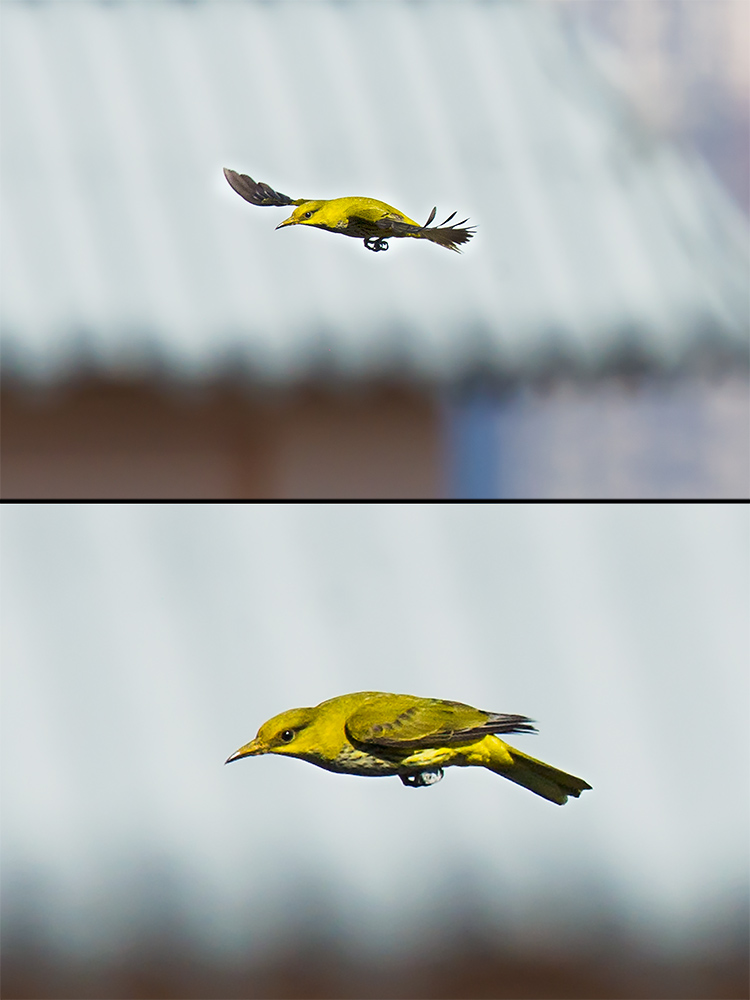
Later, atop Laifengshan, Elaine and I were standing near a flowering tree. The tree had attracted a big mixed flock, the main component of which was Rufous-vented Yuhina. I was standing in the parking lot, which is elevated from the forest floor. As I was concentrating on the birds in that tree, I noticed a man below, walking toward the base of the tree. A birdwatcher, perhaps? Yes indeed, a birdwatcher—with a slingshot. I’ve seen much destruction these past few years traveling throughout China, but I must say that it still was shocking to see a man in broad daylight about to shoot wild birds in a crowded public park. I saw him aiming, about to shoot … I called out to him. “Don’t shoot! Don’t kill birds!” Do you know what his answer was? “They’re not your birds!” As he slipped away, I saw a young child, perhaps his son, joining him. Not only did this poacher not get the memo that hunting birds is illegal, but he was also teaching this child how to do it.
Tues. 4 Feb.
Baihualing
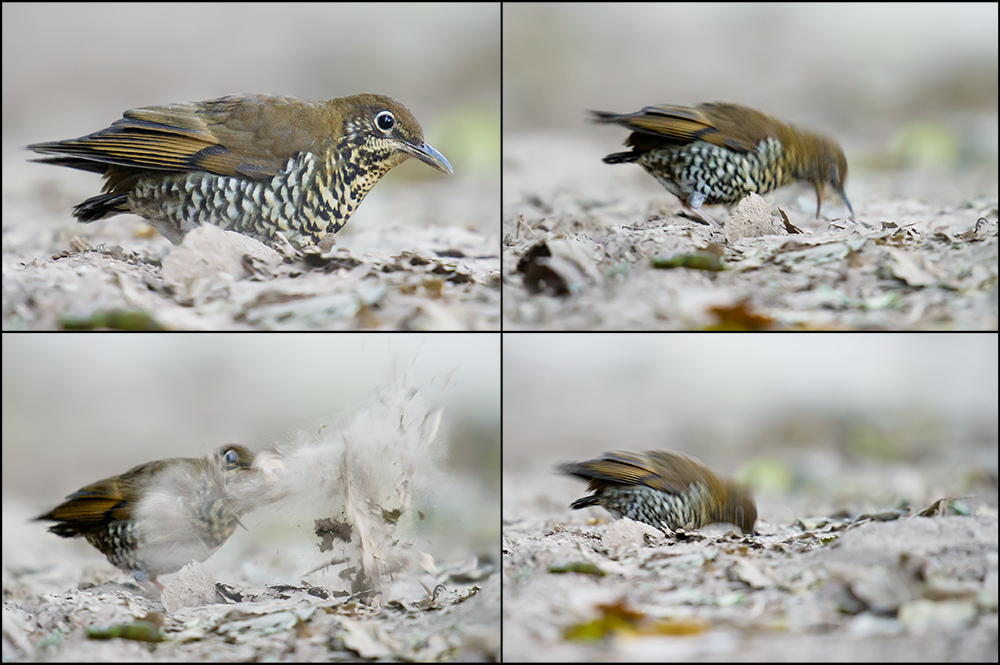
Elaine and I arrived at Baihualing in the late afternoon, having driven from Tengchong through the spectacular Salween or Nujiang (怒江) River Valley. At Baihualing, we stayed at a coffee farm operated by Duàn Lǎo Dì (段老弟; +86 159-2558-0339) and his wife, Xiǎo Gōng (小龚; +86 152-8752-0654). Their price for a simple, clean room was 100 yuan a night. There is no Internet access, and no one speaks English. Meals are not included. The food is excellent; Xiǎo Gōng and Duàn Lǎo Dì’s cousin Xiǎo Lǐ (小李) are fine cooks, and most of the vegetables and meat they use come from the farm itself. Duàn Lǎo Dì and Xiǎo Gōng are locals and know everybody in the area. They have a daughter, Xiǎo Xiǎo Gōng (小小龚), 5, who was always playing with Xiǎo Lǐ’s daughter, Xiǎo Xiǎo Lǐ (小小李), 6. The children took an interest in their Chinese-speaking “foreign uncle,” and Craig in turn introduced them to birding. We stayed 21 nights at Duàn Lǎo Dì’s farm.
Elaine and I headed uphill on the cobblestone and then dirt road toward Da Lu Chang (大陆场). As we drove, we saw one, then another, then another, then still another Zoothera thrush. I went to work on the first one we saw. It was Himalayan Thrush Zoothera salimalii. The bird was obliging, allowing me close views as it aggressively foraged among the leaf litter and on the sandy surface of the road. I got video.
Wed. 5 Feb.
Baihualing
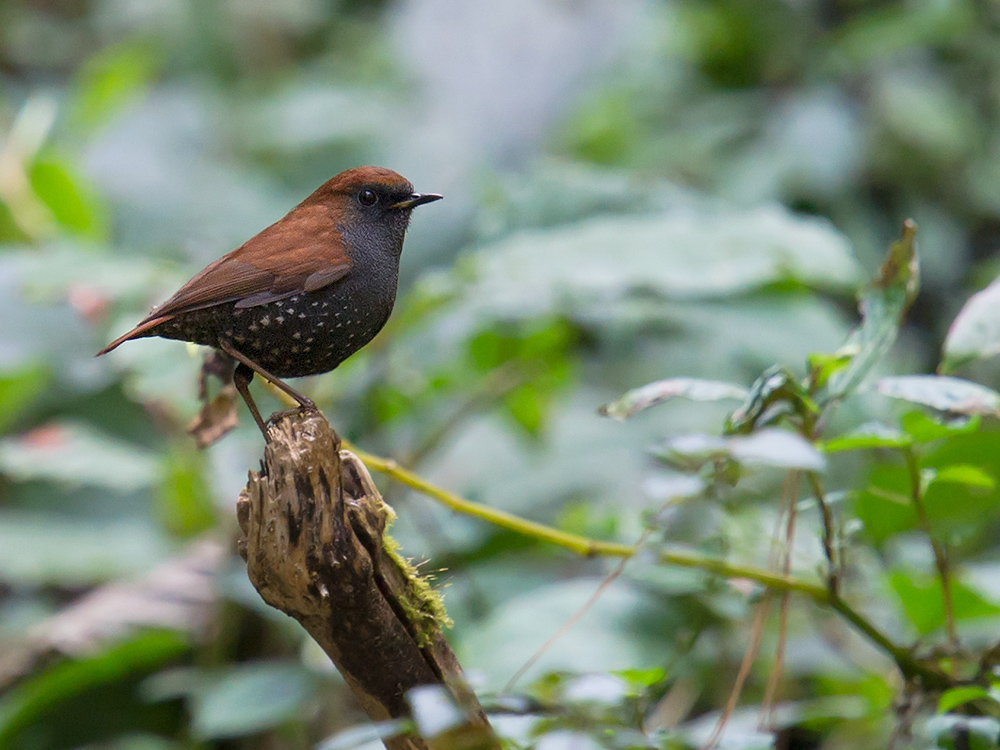
Today, Elaine and I clearly saw and sound-recorded Gould’s Shortwing. I glimpsed the beautiful bird in thick vegetation near the edge of the dirt track. Despite it not being the perfect season or habitat, our playback elicited a quick reply from the shortwing (00:11; 958 KB):
Audio PlayerThurs. 6 Feb.
Baihualing
Today Elaine and I birded at Jiujiezi (旧街子), a clearing in the forest above Baihualing. Elev.: 1990 m (6,530 ft.). Flowers are blooming all around, one can see for miles, and birds are plentiful. Here I concentrated on photography. I achieved first-ever or best-ever portraits of several species, among them Stripe-throated Yuhina. I watched a pair for a good while, noting how they switched from fly-catching to nectar-lapping and leaf-foraging. They repeated this cycle again and again. In the afternoon, back on the dirt road near Da Lu Chang, Elaine and I photographed Gould’s Shortwing. Shortwings are Masters of the Darkness. Their stealthy movements baffle the viewer. That fern just twitched—it must be the breeze. No, it’s a shortwing! How could a bird be so close to me, and I not know it? Wait, where did it go? The shortwing was almost invisible in the dark undergrowth. It appeared briefly, I took a blurry photo, and it disappeared back into the darkness.
Fri. 7 Feb.
Baihualing
We found a Gould’s Shortwing in a third gully and this time had views lasting a few minutes. Elaine finally got to appreciate this gorgeous bird. As Elaine and I were walking up the road between Da Lu Chang and Jinchang He (金厂河), a Long-tailed Thrush flew from the road into the gully, drawing our attention. I didn’t see the thrush again, but I saw another dark spot, and that dark spot was a Gould’s Shortwing. We had the privilege of watching it forage for a few minutes. When the shortwing finally disappeared, we hastily set up the tent, awaiting its return. It never returned. While in the tent, Elaine saw a Zoothera, possibly the same Long-tailed Thrush that led us into this gully. The bird turned up less than a meter from the tent. Elaine looked it in the eye. I missed the treat, staying frozen near the camera. The Zoothera crunched the leaves near us for several minutes, and even once bumped into the tent. Then it too disappeared.
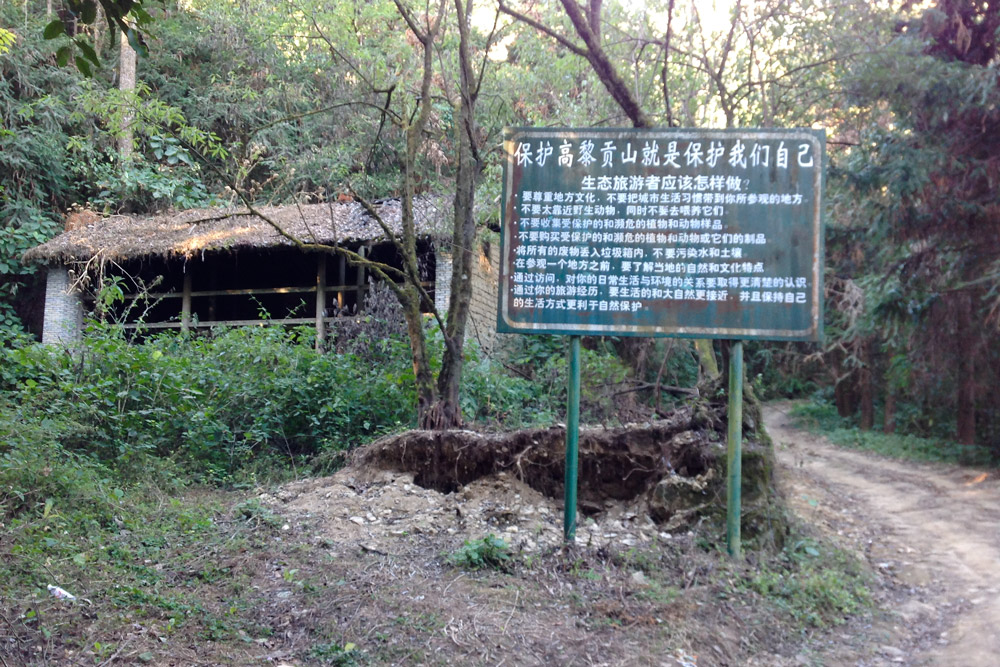
Jon Hornbuckle, a British birder and one of my partners in 2013 on a trip to Shaanxi and Sichuan, has been interested in Elaine’s and my discovery of Gould’s Shortwing. Jon has seen or heard more species of bird than anyone in the history of the world, but he hasn’t yet seen Gould’s Shortwing. Here’s what I wrote to Jon about finding Gould’s Shortwing: “We studied others’ Gaoligongshan reports (Björn Anderson, Paul Holt). Anderson said he used playback at every creek at Gaoligongshan and finally found the Gould’s. I determined to do the same. At Baihualing, following Paul Holt’s report, we parked at the abandoned two-story house on the mountain (at Da Lu Chang). This house is easy to find; it’s the largest man-made structure once you leave Baihualing Village, and it has a roof and three walls. To get to the derelict house, drive about 3 km (1.9 mi.) from the police station at Baihualing Village. A cobblestone road leads you uphill from the station. The cobblestone road eventually degrades into a dirt track but is drivable to the abandoned house, even with our low-clearance, 2WD van. A birder without his own car would have to find a guide-driver to take him to the abandoned house. Elaine and I parked at the house. At the house there is a small sign that says ‘南斋公房’ (Nanzhai Gongfang). There is also a much larger sign explaining the regulations to be observed in the national park. From the abandoned house, Elaine and I continued up the dirt road on foot, heading in the direction of Jīnchǎng Hé. Gullies cross the road, sloping downhill from the left-hand side (the ‘left-hand side’ if you’re walking uphill from the house). The first gully is broad and thickly vegetated, and the tiny stream is invisible from the dirt track. Here we found the Gould’s Shortwing without the aid of playback. A Long-tailed Thrush, startled by us, flew left, into the gully. Searching for the thrush, I saw a black speck in my binoculars. It was the shortwing. This bird permitted us to view and photograph it for a few minutes before disappearing. The day before that incident, a bit farther up from the first gully, we searched for and finally found a Gould’s Shortwing. This creek I have named Waterfall-Pipe Creek; a pipe leads down from this creek, providing water to the villages below; the waterfall is visible from the road. Another 10-minute walk further up is another stream. Here, two days before the Long-tailed Thrush led us to the Gould’s, I saw the Gould’s Shortwing for the very first time. This individual was clearly influenced by our playback. It called back, and it made a wide circle around us and our speaker. If Elaine’s and my experiences with the Gould’s Shortwing are typical, then I would advise anyone looking for the Gould’s Shortwing to search in all the creeks and gullies between Da Lu Chang and Jīnchǎng Hé.”
Sat. 8 Feb.
Baihualing
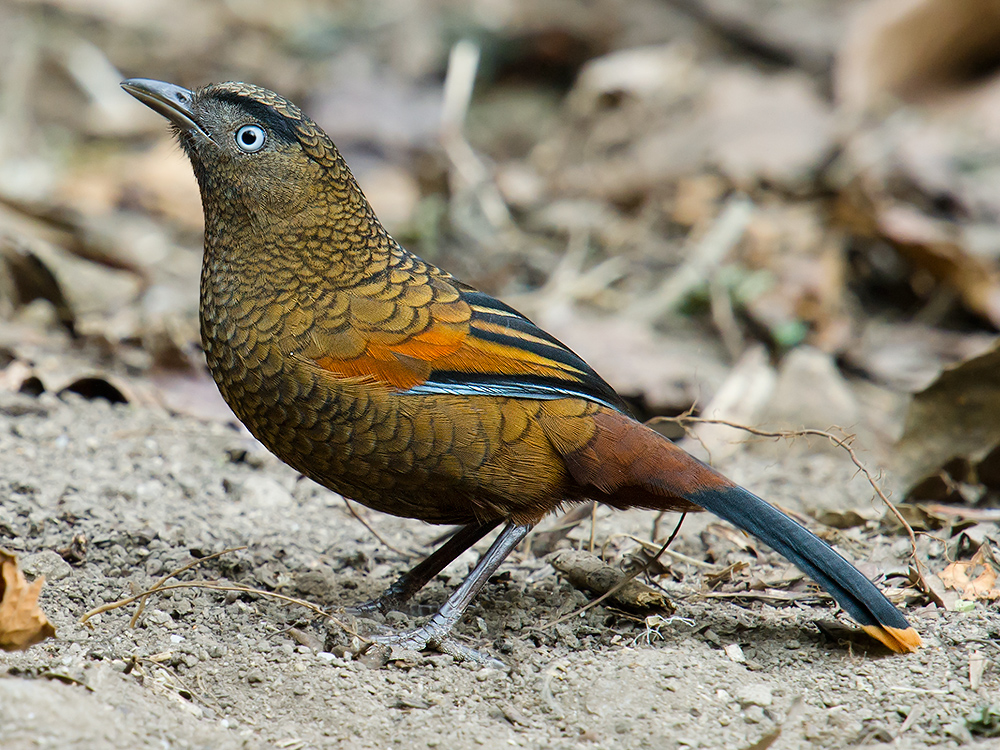
In preparation for the Baihualing leg of this long birding trip, I kept hearing the same suggestion: “Talk to Mr. Hóu” (侯; +86 135-7755-2830; no English). Mr. Hóu seems to be a kind of district supervisor here at Baihualing. Mr. Hóu oversees a system of blinds in the forest. Elaine and I were not aware of this system when we arrived here, but we are quickly learning the value of these blinds. At Blind 4 today, Elaine and I had close, and in most cases extended, views of Blue-winged Laughingthrush, Red-faced Liocichla, Rusty-fronted Barwing, Bar-throated Minla, Spot-breasted Parrotbill, Large Niltava, Small Niltava, and half a dozen other species. Most of these birds were drawn to the mealworms, uncooked rice, and water set out for them every day. But not all; the parrotbill breezed through without even a look at the setup, and the 6 Scarlet Finch and Striated Bulbul on a nearby tree never descended.
For the first three days of our stay here at Baihualing, Elaine and I were basically birdwatchers with a big camera; our biggest result was finding Gould’s Shortwings in three creeks. Today we focused on photography. I was thrilled not only to photograph, but also to see well birds such as Blue-winged Laughingthrush, one of many target species I hadn’t seen a trace of during three days hiking through the forest. The blinds at Baihualing are a good place to observe some of the most sought-after birds in western Yunnan.
Sun. 9 Feb.
Baihualing
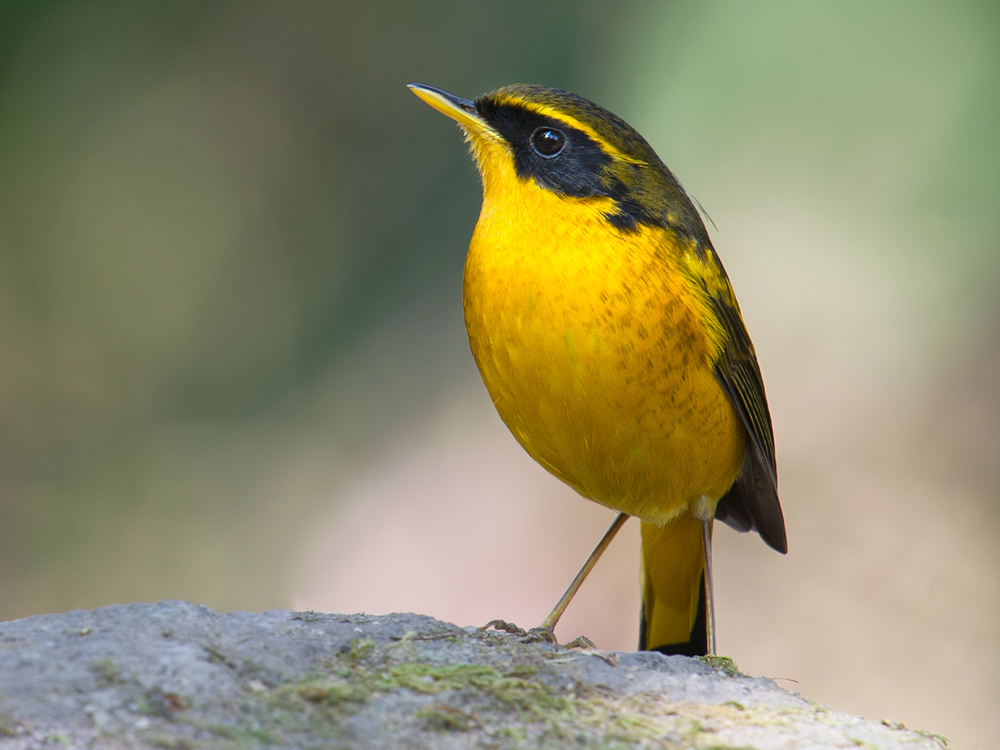
Today, Elaine and I were at Blind 6. Around noon, a bird wave descended on the little clearing there. The frenzy was led by 6 Red-tailed Laughingthrush. These beautiful birds, noisily calling and bathing, attracted Golden Bush Robin, Orange-bellied Leafbird, Grey-headed Parrotbill, Black-headed Sibia, 2 Whiskered Yuhina, Stripe-throated Yuhina, Blue-tailed Minla, 2 Chestnut-vented Nuthatches, and 3 Rusty-fronted Barwings. A male and female Large Niltava, Rufous-gorgeted Flycatcher, and 2 Himalayan Bluetail were also in the area. Behind the blind were 5 Buff-barred Warbler. With the frenzy, we packed a day’s worth of birding into 10 minutes.
Mon. 10 Feb.
Baihualing
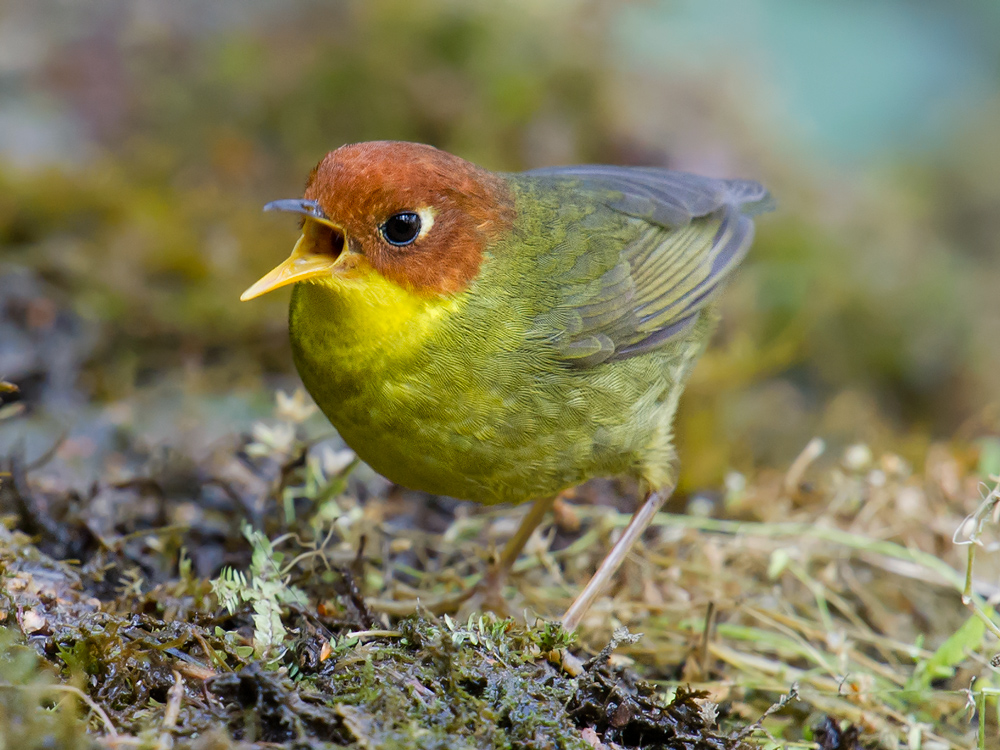
Today at Blind 1, the star bird was the single Chestnut-headed Tesia that lives in the vicinity. During a bird wave, the world’s three species of minla were present simultaneously. We got an image of Himalayan Bluetail. As darkness was falling and after all the other photographers had gone, Elaine and I were rewarded for our persistence with close views of Pygmy Cupwing.
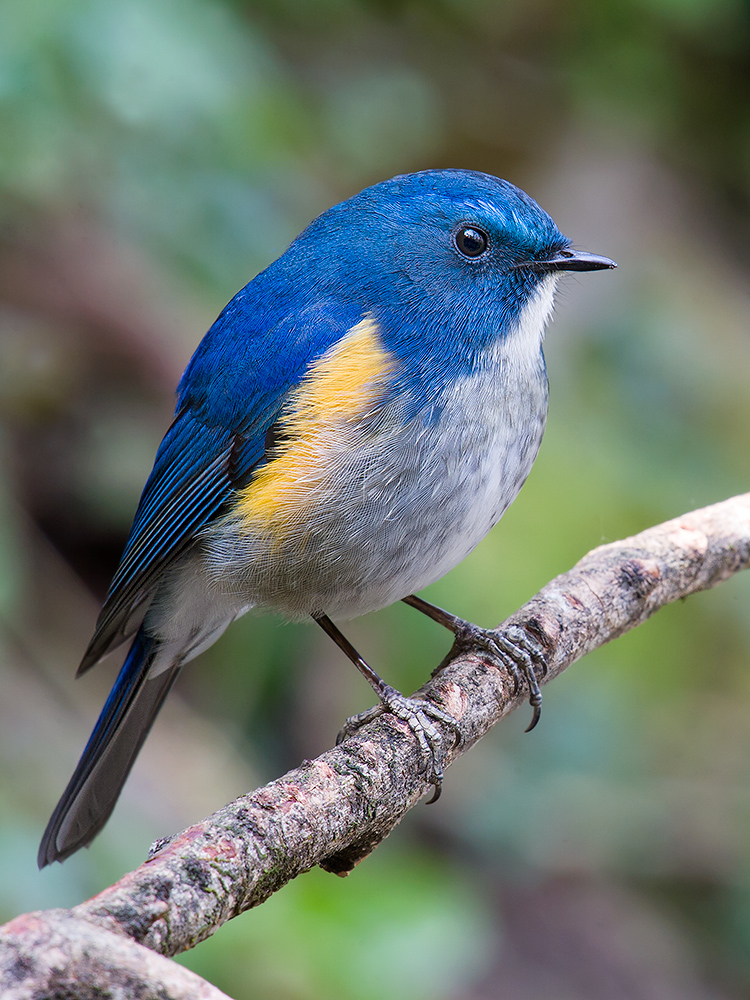
Tues. 11 Feb.
Baihualing
Today at Blind 12, elev. 1850 m (6,070 ft.), four species of laughingthrush were present simultaneously for 10 glorious minutes. The species: Black-faced Laughingthrush, Assam Laughingthrush, Grey-sided Laughingthrush, and Red-tailed Laughingthrush. Also, Cachar Wedge-billed Babbler were heard near Blind 12 today but did not appear. When the wedge-billed babblers called, I immediately pointed out the significance of the bird to the other photographers in Blind 12. Two of them even learned the call and could whistle it. Everyone in the blind was hoping that the wedge-billeds would appear. Those guys went from not even knowing what a Cachar Wedge-billed Babbler is to waiting with bated breath to see it.
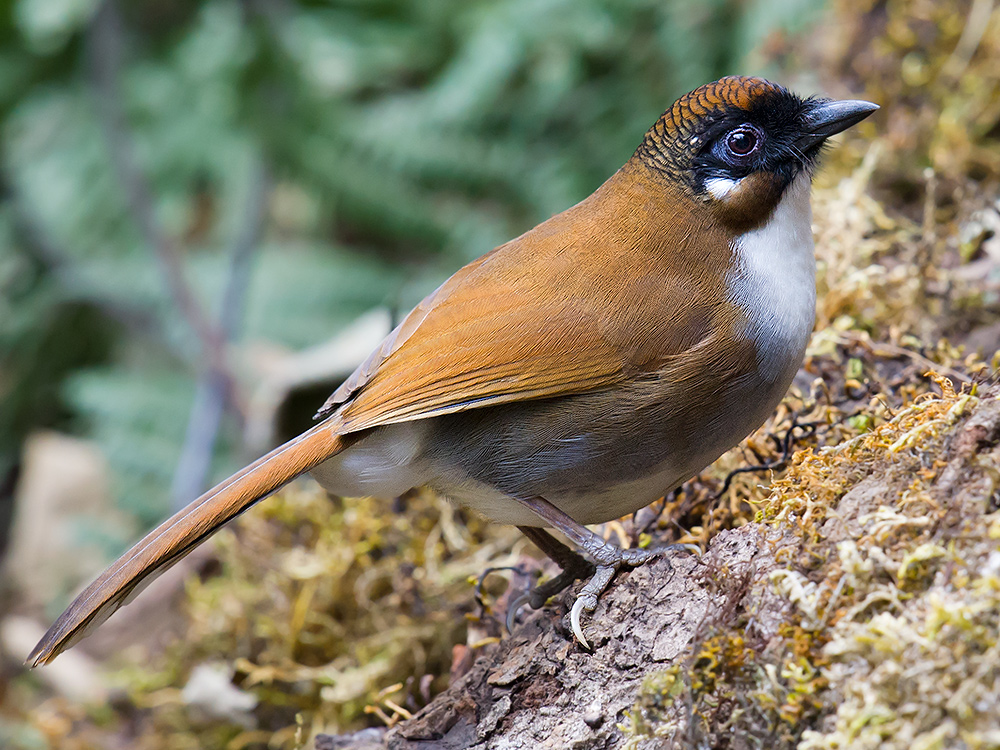
Wed. 12 Feb.
Baihualing
Today at Blind 10 at Baihualing, Elaine and I saw 18 species, among them our bird of the trip: a single Slender-billed Scimitar Babbler. Our other star today was 2 Moustached Laughingthrush. The Slender-billed Scimitar Babbler stayed only a minute, but that minute made our entire day. After another successful day in the blinds, I’m becoming more and more of a believer in the concept. The young man who guided us to Blind 10 today told us that about eight or nine young men like him serve as bird guides. These guys, all in their 20s and from the area, take photographers to and from the blinds. They probably make an adequate living doing this. Without the photographer-tourists, what would these young men be doing in the Baihualing forest? In more than a week here at Baihualing, I have yet to find bird netting, and I haven’t seen poachers. In other bird-rich but tourist-poor areas in Yunnan, I’ve found netting and seen poachers within hours of my arrival. The local people seem to take pride in their still-beautiful region. I see a glimmer of hope here at Baihualing.
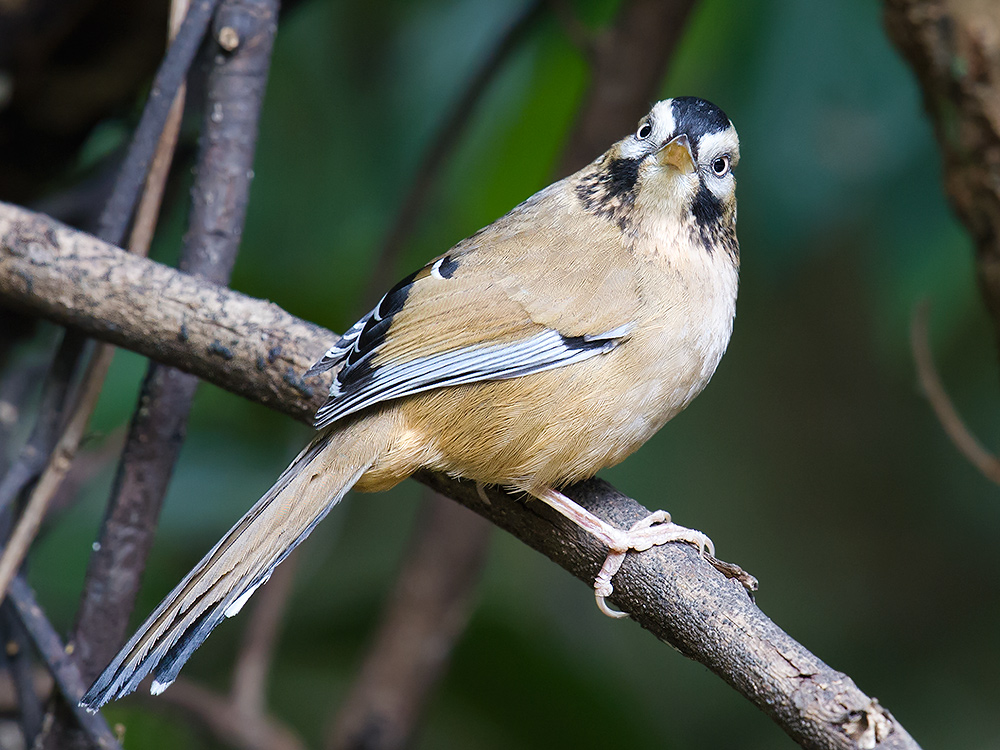
Thurs. 13 Feb.
Baihualing
Today at Blind 3 Elaine and I made a list of the differences between Long-tailed Thrush and Scaly Thrush. Because the two birds have grown used to Blind 3, the area in front of us became a laboratory, where the two Zoothera species could be viewed in action. The most obvious difference may be in the way the two species ambulate: The Scaly creeps, moving one foot in front of the other; the Long-tailed hops, like a typical thrush. At first, the larger Scaly was chasing off the Long-tailed, as well as a single male Chestnut-bellied Rock Thrush. Interestingly, the Scaly was not driving off the smaller Bar-throated Minla and Stripe-throated Yuhina that were coming down to drink and bathe. Apparently the Scaly can distinguish between birds that compete with it for food and birds that do not. As the forest darkened, the Scaly ceased driving off the Long-tailed. Another favorite today was 2 Yellow-browed Tit.
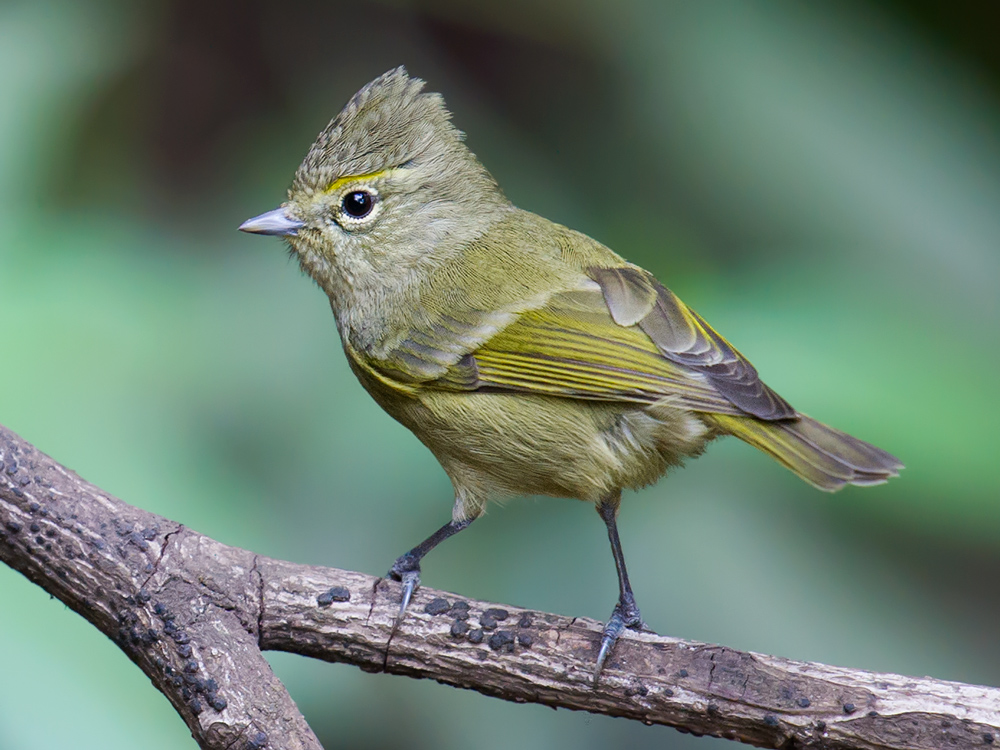
Fri. 14 Feb.
Baihualing
Baihualing is full of natural goodness. There’s a hot spring a 30-minute walk from the parking lot above the village. Today, Valentine’s Day, after many hard days birding, Elaine and I decided to relax at the hot spring. I took my equipment and birded the way down. Our main target was the Scarlet Finches that Elaine and I saw high in a tree last week but have yet to photograph. This morning, one or perhaps two “Blood Finches” (Chinese for “Scarlet Finch”) were calling downslope but never appeared. Farther down, we added Hume’s Treecreeper to our trip list. Stopping briefly at Blind 4, we found a pair of Red-faced Liocichla and a Pygmy Cupwing. Further down, near the little waterfall, in habitat perfect for a wren-babbler, we weren’t surprised to hear another Pygmy Cupwing making its “tsk” call. The hot spring proved that there are still some good things in life that are absolutely free. For no cost except the wear on our legs to get there, we bathed and swam for two hours in the clear, warm water.
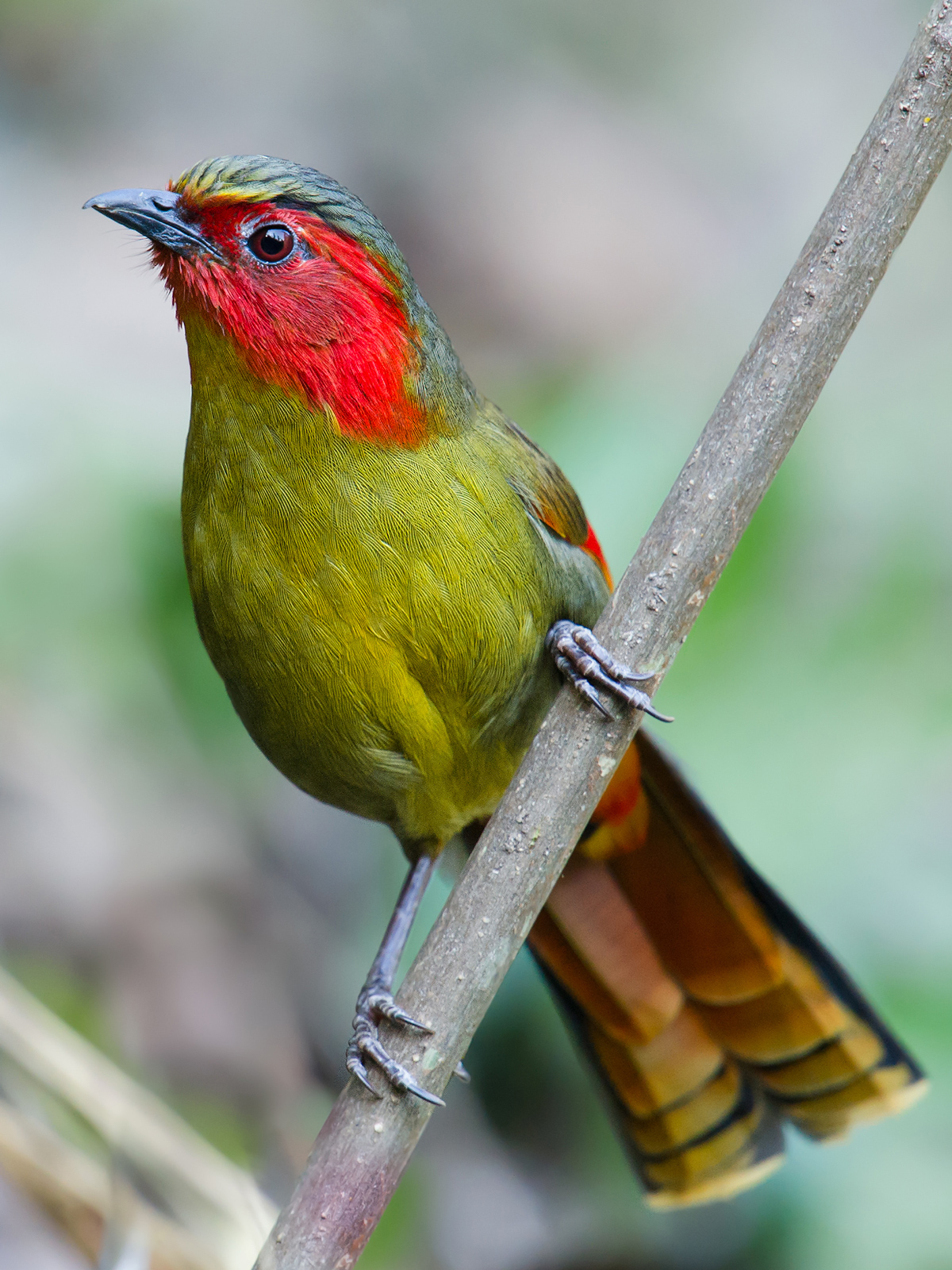
After the swim, feeling completely refreshed, I studied the 2 Spotted Forktail living near the spring. I noted their course through the area and memorized the rocks they were alighting on. As today was supposed to be an off day, I hadn’t taken my tent and camouflage to the hot spring. I decided to try anyway for high-quality photos of my fifth and final species of forktail in China. I crawled onto a rock in the middle of the creek and trained my lens on my target rock. I guessed correctly; within 20 minutes, a Spotted Forktail landed on my target rock, and just like that I’d got my photos. On this Yunnan trip, Elaine and I have had close encounters with all five species of forktail in China. A walk back up to the car netted us clear views of a Grey-bellied Tesia. Elaine sound-recorded its call.
Sat. 15 Feb.
Baihualing
Elaine and I saw and sound-recorded a Bay Woodpecker. A good piece of birding on my part netted me this new species. After sundown, Elaine and I were still at Jiujiezi. A bird with a head lighter than its mainly brownish body flew across the open area, laughing hysterically. I noted its undulating flight, characteristic of a woodpecker. The bird alighted in the darkness somewhere. Its squirrel-like cackling was coming from the top or middle of a tree. No photo was possible, but my handy Olympus DM-640 captured the laughter and the cackling. My visual impression combined with my recording made ID a simple task. Scanning the woodpeckers in Robson’s Birds of Southeast Asia, I came across Bay Woodpecker. Robson’s succinct description of its voice was useful: “harsh descending laughter.” All that was needed now was to match the recording on my device with the recordings of Bay Woodpecker on my iPhone. The match was perfect.
Sun. 16 Feb.
Baihualing
Today, for the first time since arriving in Yunnan on 15 Jan., rain interrupted our birding. But even the early end to our day couldn’t stop the flow of new species into our trip list. Our new birds today were 3 Himalayan Cutia and 5 Streak-throated Barwing. We were at Er Taipo (二台坡), elev. 2230 m (7,320 ft.). Er Taipo is a 30-minute walk above Jiujiezi on the Cha-Ma Gudao (茶马古道) or “Ancient Tea-Horse Road.” This road, also known as the Southern Silk Road, dates from the 6th century; portions of it are still in use at Baihualing, and one can walk to Tengchong on this road in about nine hours.
Mon. 17 Feb.
Baihualing
Today, for the first time in about 135 winter birding days in Yunnan (2010, 2012, 2014), I lost an entire day to rain. I switched to desktop birding, working with Elaine to turn our day lists into a trip list. After more than a month in Yunnan, we had much to do.
Tues. 18 Feb.
Baihualing
In the afternoon, after the rain finally let up, an Oriental Magpie-Robin started singing powerfully in the coffee bushes next to the house where Elaine and I are staying. The beautiful song was a summons to action. Above 1600 m (5,250 ft.), light rain was still falling. A massive bird wave descended on the trees by the side of the road. The wave contained many Yunnan specialties, among them 3 Long-tailed Sibia and 4 Striated Bulbuls. Up above, at Er Taipo, elev. 2230 m (7,320 ft.), we failed to find our Himalayan Cutia and Streak-throated Barwing. We were consoled by a good view of a Crimson-breasted Woodpecker. As the sun was going down, Elaine and I hurried back down to Jiujiezi. Looking up at the distant ridge, we saw a frosting of snow on the slopes above 3000 m (9,840 ft.). At Jiujiezi we recorded Stripe-throated Yuhina (00:31; 1.3 MB):
Audio PlayerWed. 19 Feb.
Baihualing
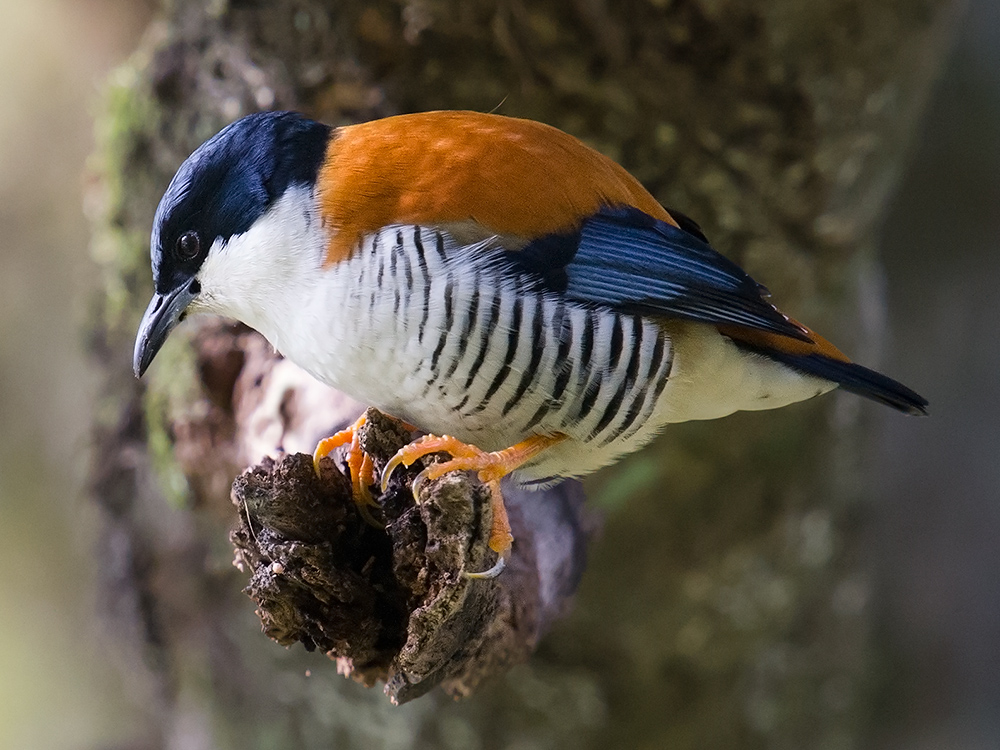
Today, I finally photographed Himalayan Cutia. Elaine and I also found Gould’s Shortwing in our fourth creek here at Baihualing. To photograph the cutias, I carried my 600 mm lens and all my other camera equipment 440 vertical meters (1,440 vertical feet) up on the Tea-Horse Road, from our parking place at Jiujiezi, elev. 1990 m (6,530 ft.), past Er Taipo, elev. 2230 m (7,320 ft.), and Dà Fēng Bāo (大峰包), elev. 2400 m (7,870 ft.), to Kàng-Rì Zhànzhēng Yíjì Zhànkēng (抗日战争遗迹-战坑), elev. 2430 m (7,970 ft.). (The long Chinese name means “Memorial Bomb Crater from the War of Resistance Against Japan.”) Near the crater, we found a pair of cutias. We watched them for about an hour. My camera recorded the birds stripping away bark and lichen to get to the invertebrates inside. Earlier, below Dà Fēng Bāo, Elaine and I played our recording of a Gould’s Shortwing. Within seconds we heard a reply, and a few seconds thereafter the shortwing appeared.
The forest we walked through today was quiet, clean, and of very high quality. Lower down, the forest has obviously been logged, but along the Tea-Horse Road, one sees little evidence of logging. Indeed, there are many tall, thick trees decades old. Having seen so few forests of such quality in China, I was enchanted by the place. The romance of the ancient highway, the old route through Burma to India and beyond, added to our enchantment. Perfect weather, a good partner, an ancient road leading through a healthy forest, and good birds: Life doesn’t get much better than this.
Here’s a Collared Owlet that we heard along the road today (00:32; 1.3 MB):
Audio PlayerThe voice of Beautiful Sibia is a common sound in the Baihualing forests (00:16; 1 MB):
Audio PlayerThu. 20 Feb.
Baihualing
After having spent a day in all the major blinds in the area, Elaine and I decided to revisit one of the better ones, Blind 10. This was a risky move, because we had already seen all the major birds expected at Blind 10, with the exception of Scaly Laughingthrush. We therefore were placing all our chips on one species. The day turned out to be a rerun of 12 Feb., our first day at Blind 10, the main difference being that this time the Slender-billed Scimitar Babbler only passed through the area, never stopping to bathe. No Scaly Laughingthrush appeared.
Fri. 21 Feb.
Baihualing
The tediousness of Blind 10 yesterday convinced Elaine and me that we’d be better off focusing on more rarely seen birds on the Tea-Horse Road. Today, Elaine and I walked on the ancient road from Jiujiezi to Yellow Bamboo Creek (Huáng Zhú Hé [黄竹河]). The high-quality, little-disturbed forest continues all the way to Yellow Bamboo Creek. We found one of the specialties of the area: 2 Black-headed Shrike-babbler. Nearby, we found their congener, Black-eared Shrike-babbler. We were surprised that between Dà Fēng Bāo and Yellow Bamboo Creek, the Tea-Horse Road barely rises at all (although after Yellow Bamboo Creek, the trail begins a sharp ascent, finally topping out at 3180 m [10,430 ft.]). Since a walk from Jiujiezi to Yellow Bamboo Creek and back takes the better part of a day, the part of the Tea-Horse Road beyond Yellow Bamboo Creek remains beyond the reach of most birders. There is a solution, however, and that is to camp out at the pass above Yellow Bamboo Creek. From 25 Feb. to 1 March, Elaine and I did just that.
Sat. 22 Feb.
Baihualing
Today, I learned the origin of the word “tesia.” These birds tease ya; they make a lot of noise and shake the vegetation near ya, but they rarely pop out. A Grey-bellied Tesia has set up shop along the Tea-Horse Road near Blind 4, where we waited for him today. Elaine managed to make eye contact with the tesia for just one or two seconds.
Sun. 23 Feb.
Baihualing
Today, amid the many old-growth trees around Dà Fēng Bāo, Elaine and I got high-quality sound recordings and photos of Hume’s Treecreeper, a species whose range in China extends no further than Gaoligongshan. We recorded both the explosive call and the rattling call.
explosive call (00:14; 1 MB)
Audio Playerrattling call (00:14; 1 MB)
Audio Player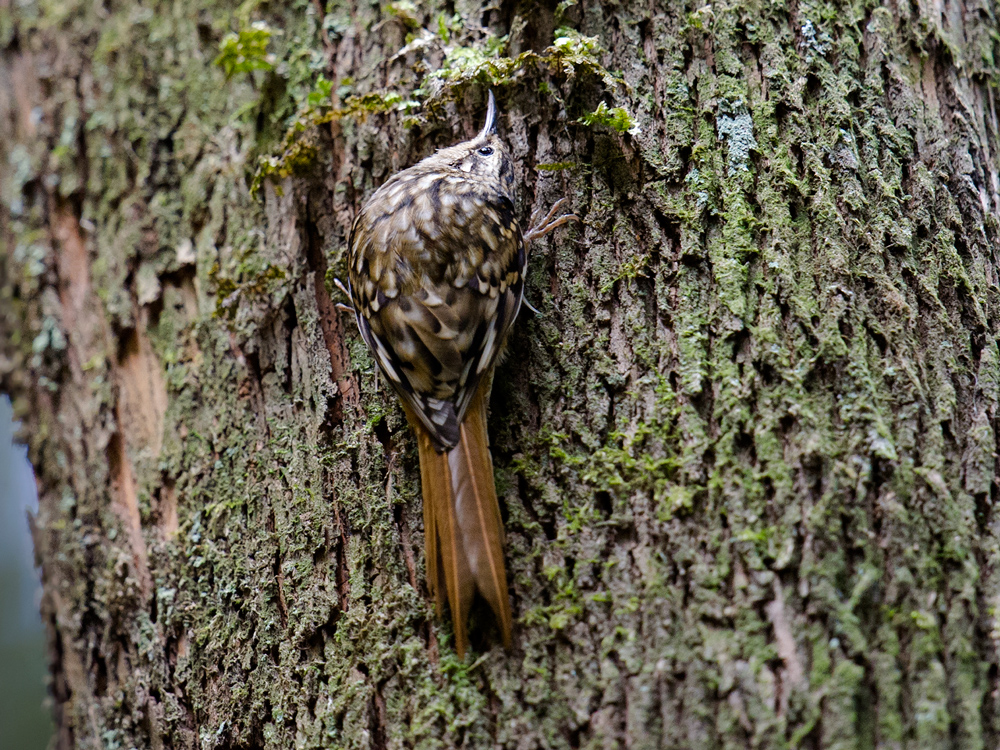
Mon. 24 Feb.
Baihualing
Sometimes record shots are the most prized shots of all. Today, I took blurry photos of White-throated Laughingthrush. As Elaine and I were eating lunch at Dà Fēng Bāo, a flock of perhaps 100 of these birds suddenly appeared. They were moving quickly and staying in the upper canopy, and the wave soon crossed the Tea-Horse Road. I followed off-road, carrying my Nikon D3S and 600 mm lens through the forest. Even though there were so many birds, getting a good view of them, much less a photo, was difficult; as soon as I would aim, the birds would fly off. But I knew what I wanted—a record shot at the very least—and I refused to give up. Finally, I managed a few blurry images. At first, I was disappointed, but later, I came to value the images. Because I got the photos, and because they are just clear enough to allow one to determine the species, it is easy enough to tell that the birds are White-throated Laughingthrush. Those few moments were my only experience with that species on the Yunnan trip.
Tues. 25 Feb.
Baihualing
Today, we began a four-night trip to the top of the mountains. We started walking at Jiujiezi at 08:00. Making fast time on the Tea-Horse Road, we arrived at Yellow Bamboo Creek at 09:50. We were well ahead of our excellent muleteer, Duàn Shēng Hóng (段生洪; +86 187-2526-9387). Xiǎo Duàn had two mules carrying our stuff; the price is 200 yuan per mule one way, minimum two mules; the round trip, therefore, cost 800 yuan. Sure enough, after Yellow Bamboo Creek the Tea-Horse Road rises steeply. At about 2800 m (9,190 ft.), we saw the first bits of snow on the ground, we heard the grating calls of Spotted Nutcracker, and we saw Coal Tit. At 12:30 we arrived at our destination, Nanzhai Gongfang (南斋公房), elev. 3180 m (10,430 ft.). Nanzhai Gongfang is a house built at the pass where the Tea-Horse Road crosses the Gaoligong Mountains. The view to the east is excellent; the Salween Valley spreads before you. To the west, not visible from Nanzhai Gongfang, is Tengchong. At Nanzhai Gongfang, snow still covered the shady areas. The dominant plant up there is a hardy species of yellow bamboo. Our muleteer asked us to set up our tent in the courtyard at Nanzhai Gongfang, to shelter us from the wind; but as the house resembled a garbage dump, I refused, and set up the tent on a terrace above the house. After a rest in the tent, we walked along the ridge. We found a pair of Spotted Laughingthrush and recorded their strange calls (00:12; 975 KB):
Audio PlayerWed. 26 Feb.
Baihualing
When Elaine and I awoke this morning near Nanzhai Gongfang, the walls of our tent were covered with frost, our frozen breath. There are few birds at Nanzhai Gongfang; we realize we’re too early in the season, but I just had to see this place, and in any case we now are finally able to bird the elevations between 2400 m (7,870 ft.) and 3180 m (10,430 ft.). We headed lower on the eastern side. At 3000 m (9,840 ft.), we found an Ashy-throated Warbler. At 2990 m (9,810 ft.), we found a male Green-tailed Sunbird. At 2850 m (9,350 ft.), we found White-browed Fulvetta. We were amazed at the inquisitiveness and fearlessness of the pair we saw. They sound like this (00:49; 1.6 MB):
Audio Player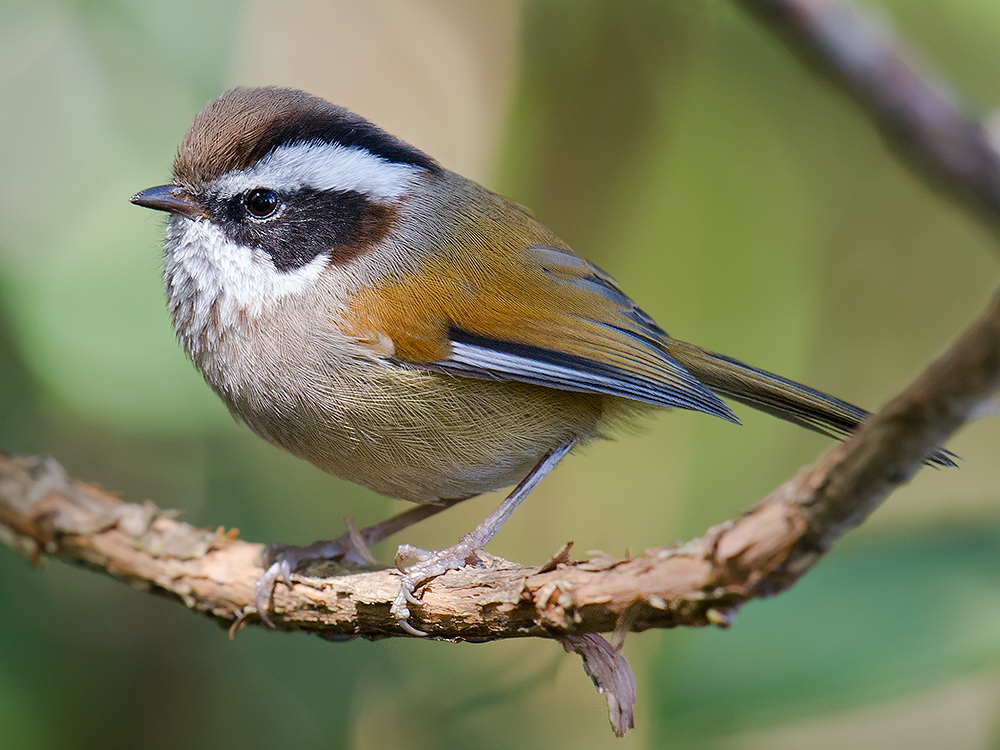
At Yingke Shan (迎客杉), elev. 2840 m (9,320 ft.), we found a flock of Red Crossbill. Lower still, where the bamboo grows tall and thick, we found a lively flock of about 20 Fulvous Parrotbill. We descended to 2710 m (8,890 ft.). We would have gone farther down, but there’s a problem: From about 2700 m (8,860 ft.) down to Yellow Bamboo Creek at 2400 m (7,870 ft.), much of the Tea-Horse Road resembles a tunnel, with walls on either side, in places more than 2 meters (6 feet) high. The walls make birdwatching difficult, but are themselves fascinating, as they attest to the great age of the Ancient Tea-Horse Road. The walls are made of topsoil that has accumulated on the sides of the road for the past 1,500 years. Because of the hard surface of the road, and because humans and animals using the road trample down any large vegetation, trees don’t grow there, and dead vegetation doesn’t accumulate there; the road therefore remains at the level it was built at 1,500 years ago. But on the sides of the road, trees and other plants grow; as they die and decay, they form topsoil.
Thurs. 27 Feb.
Baihualing
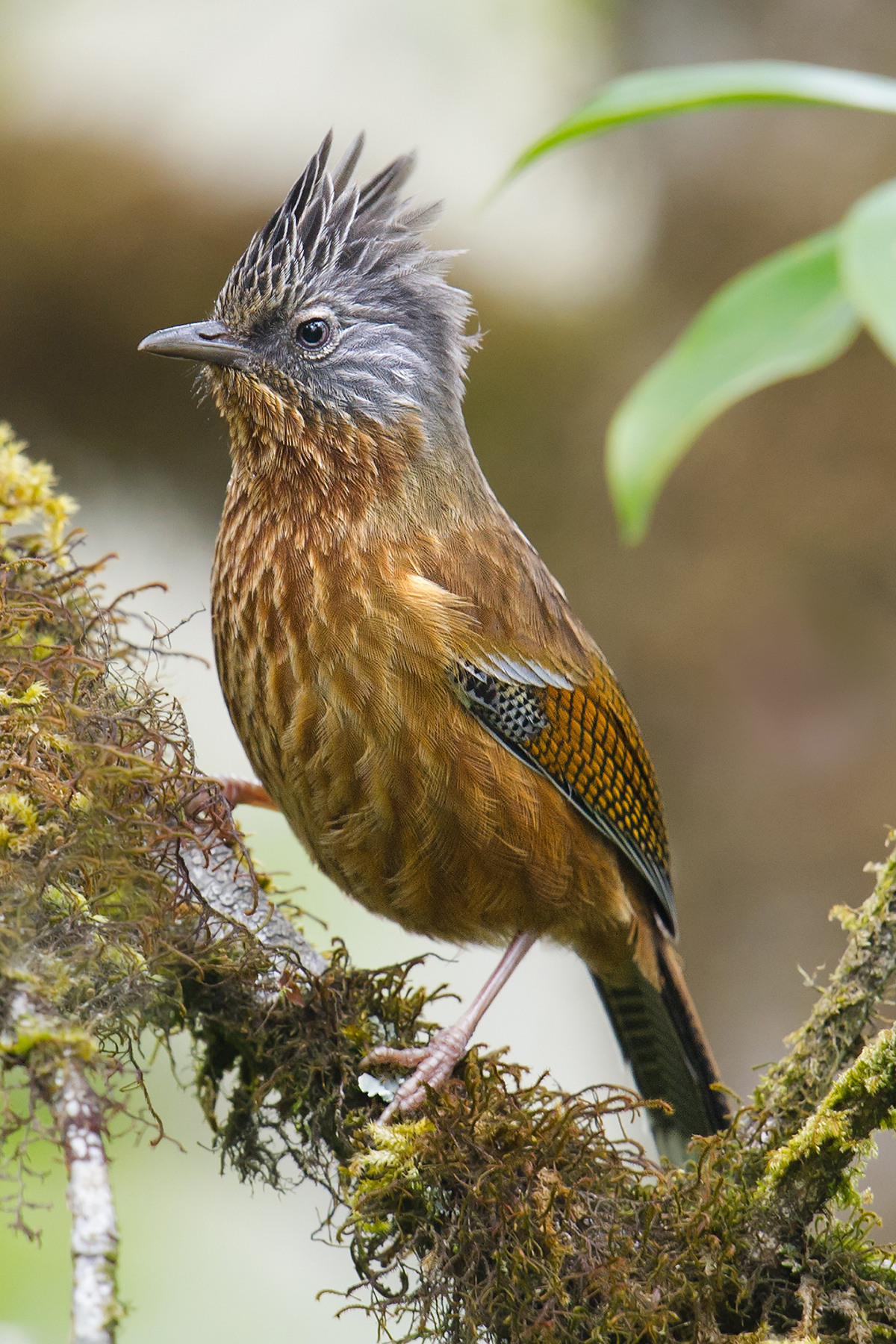
We’re still in our tent on the terrace above Nanzhai Gongfang. When I awoke this morning, I found a Himalayan Bluetail and a pair of White-browed Fulvettas near our tent. Elaine and I once again walked toward Baihualing on the Tea-Horse Road, again descending to an elevation of about 2700 m (8,860 ft.) before retracing our steps to Nanzhai Gongfang. Just below Yingke Shan, at an elevation of about 2800 m (9,190 ft.), we found 4 Grey Crested Tit. A Streak-throated Barwing alighted on a branch and began probing the lichen. Although just 7 meters away, the beautiful bird was unconcerned by me. Elaine and I walked slowly up, being careful not to work up a sweat. At about 3000 m (9,840 ft.), we found Darjeeling Woodpecker. Eating supper in our tent, I heard honking overhead. 3 Common Crane were attempting to cross the Gaoligong Mountains. They were flying in a southwesterly direction. A headwind blowing over the pass kept the cranes above us for a minute or so. The cranes struggled against the headwind, hovering right above us, before finally overcoming the wind and disappearing.
Fri. 28 Feb.
Baihualing
Elaine and I explored the western side of the Gaoligong Mountains. Leaving our camp at Nanzhai Gongfang, we followed the Tea-Horse Road toward Tengchong. We descended to about 2700 m (8,860 ft.) before turning back. The highlight of the day was photographing a Black-browed Bushtit and Black-faced Laughingthrush drawn to fruiting trees at 2890 m (9,480 ft.). We also had female Temminck’s Tragopan at 2940 m (9,650 ft.). The western side is steeper than the eastern side. Below the pass and for a few hundred meters in elevation thereafter, the Tea-Horse Road runs parallel to a creek in a narrow gorge. The western side seems to be windier than the eastern side; at least, the wind was blowing strongly today. As was the case yesterday, Elaine and I saw no one all day; the last human beings we saw were three hikers on Wednesday.
Sat. 1 March
Tengchong
Today, our 46th day of the trip, I reluctantly left the mountaintop and loaded my equipment onto the mules. I carried my Olympus DM-650, using it to acquire an excellent set of recordings of a Yellow-cheeked Tit (00:22; 1.1 MB):
Audio PlayerWe also found this Golden-throated Barbet (00:16; 1 MB):
Audio PlayerAt Jiujiezi, a driver sent by Duàn Lǎo Dì was waiting to take us back to the coffee farm and our van. After saying goodbye to the kids and settling up with Xiǎo Gōng, Elaine and I drove to Tengchong.
Sun. 2 March
Shanghai
When we began this trip, the odometer on our Chang An van read 48,650 km (30,230 mi.). When we finished today, the odometer read 50,175 km (31,177 mi.). On a 47-day trip, Elaine and I drove only 1,525 km (948 mi.), a per-day rate of just 32 km (20 mi.). In western Yunnan, one gets a lot of bird for the buck.
At Tengchong Airport, we returned the van to Xiāo Xù Qīng. Elaine and I got our flight to Kunming, which was under heavy security in the wake of the knife attack by terrorists. We flew back to Shanghai.
PLACE NAMES
Bǎihuālǐng (百花岭): “Hundred Flower Ridge”; area in Gāolígòngshān National Park, in the southern part of the Gāolígòng Mountains
Chá-Mǎ Gǔdào (茶马古道): “Ancient Tea-Horse Road”; also known as the Southern Silk Road; dates from 6th century; portions of it are still in use at Bǎihuālǐng
Dà Fēng Bāo (大峰包): point on the Chá-Mǎ Gǔdào; elev.: 2400 m
Dà Lù Chǎng (大陆场): point on the main unpaved road at Bǎihuālǐng; an abandoned house is there; elev.: 2040 m
Èr Táipō (二台坡): point on the Chá-Mǎ Gǔdào; elev.: 2230 m
Gāolígòng Mountains: mountain range in western Yunnan running north-south approximately 500 km and dividing the Salween and Irrawaddy River basins
Gāolígòngshān (高黎贡山): see Gāolígòng Mountains
Huáng Zhú Hé (黄竹河): “Yellow Bamboo Creek”; creek that intersects the Chá-Mǎ Gǔdào at Bǎihuālǐng; elev.: 2400 m
Jīnchǎng Hé (金厂河): major stream at Bǎihuālǐng; elev.: 2300 m
Jiùjiēzi (旧街子): point on the Chá-Mǎ Gǔdào; elev.: 1990 m
Láifèngshān (来凤山): large forest park in Téngchōng
Lǎn Bǎndèng (懒板凳): point on the Chá-Mǎ Gǔdào; elev.: 2990 m
Mèngnǎi River (勐乃河): river rising in China and forming part of border between China and Burma
Nàbāng (那邦): town on China-Burma border
Nàbāng Creek (那邦河): stream forming part of border between China and Burma; Craig named it “All Forktail Creek” because he and Elaine found four of China’s five species of forktail there and the fifth, spotted forktail, could occur there; Nàbāng Creek is one of the few streams in China on which all of China’s species of forktail may be found
Nàbāng-Xīmǎ Trail (那邦-昔马路): ca. 30 km long, linking the two towns for which it is named
Nánzhāi Gōngfáng (南斋公房): building near pass on Chá-Mǎ Gǔdào, Bǎihuālǐng: elev. of pass: 3180 m; elev. of building: 3160 m
Róngshù Wáng (榕树王): nature preserve in the mountains above Nàbāng, named after the massive banyan tree found there
Téngchōng (腾冲): city in western Yunnan, near the Gāolígòng Mountains
Yíngjiāng (盈江): city in western Yunnan, between Téngchōng and Nàbāng
Yíngkè Shān (迎客杉): point on the Chá-Mǎ Gǔdào, named after a tall Chinese fir tree; elev.: 2840 m
Zhànkēng (战坑): short for Kàng-Rì Zhànzhēng Yíjì Zhànkēng (抗日战争遗迹-战坑; “Memorial Bomb Crater from the War of Resistance Against Japan”); point on the Chá-Mǎ Gǔdào; elev.: 2430 m
ACKNOWLEDGEMENTS
Steve Bale provided a steady stream of encouragement and tips. Paul Holt opened up his treasure chest of Yunnan reports to us. Per Alström sent Craig a recording of Gould’s Shortwing. Jesper Hornskov followed our progress and gave us tips. We got much good information from reports by Björn Anderson. Brian Ivon Jones offered constant support, interest, and encouragement.
Featured image: Slender-billed Scimitar Babbler Pomatorhinus superciliaris, Baihualing, Yunnan, 12 Feb. 2014. (Craig Brelsford)

